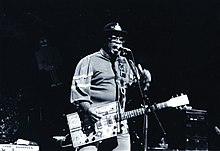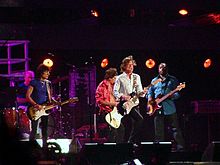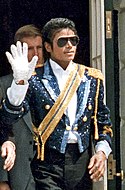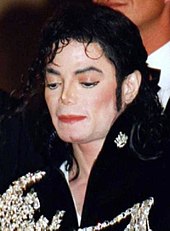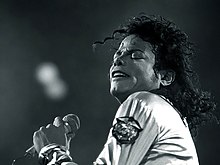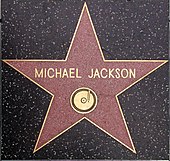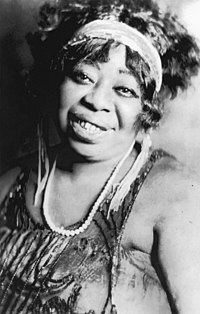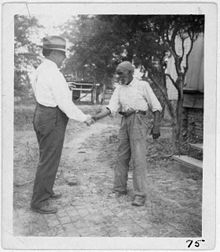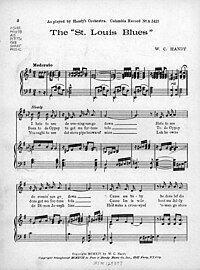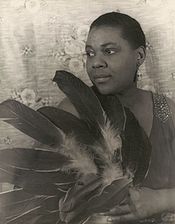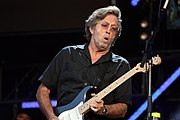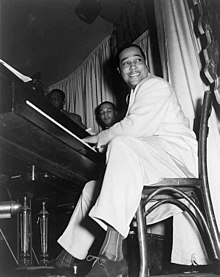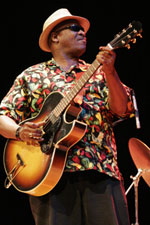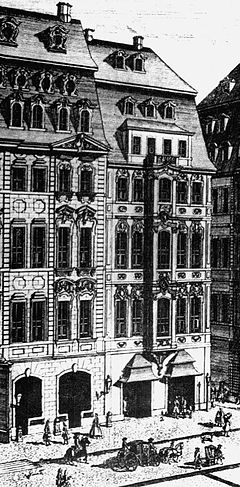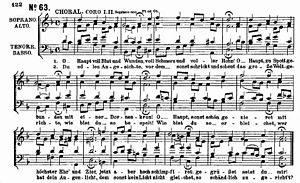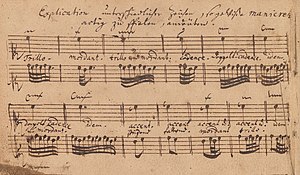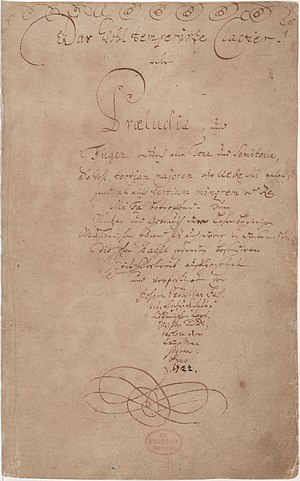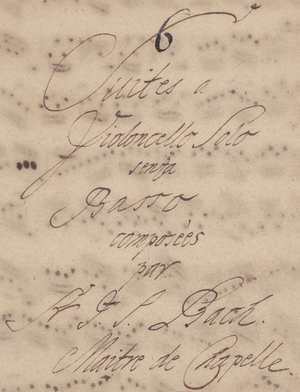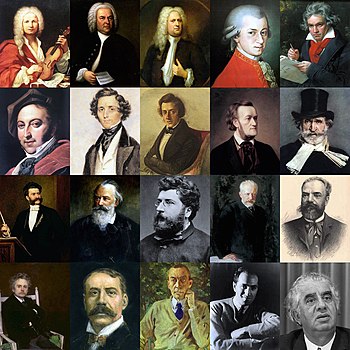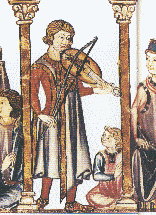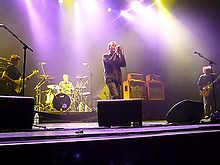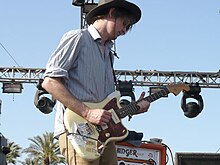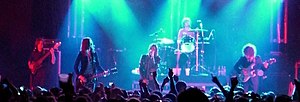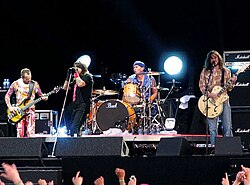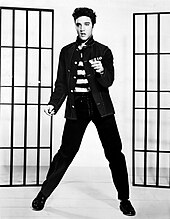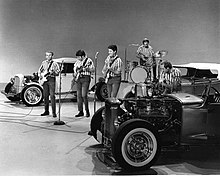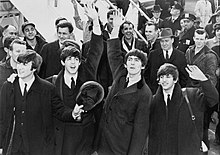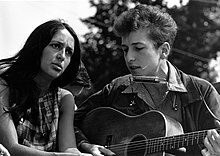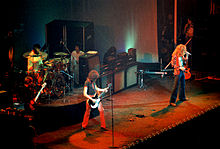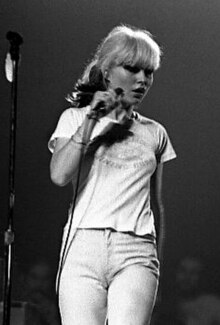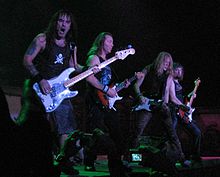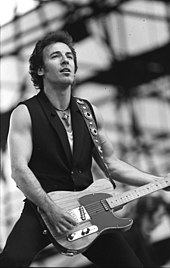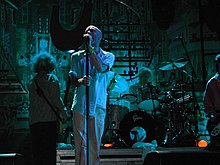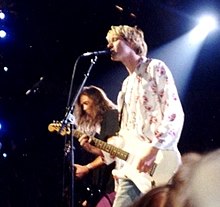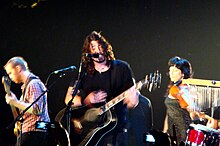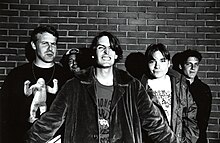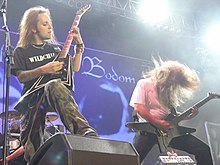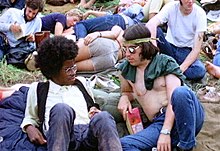| Michael Jackson |

|
| Born |
Michael Joseph Jackson
August 29, 1958
Gary, Indiana, U.S. |
| Died |
June 25, 2009 (aged 50)
Los Angeles, California, U.S. |
| Cause of death |
Homicide[1] (Involuntary manslaughter)[2] |
| Resting place |
Glendale, California, U.S. |
| Residence |
Los Olivos, California, U.S. |
| Occupation |
- Singer
- songwriter
- dancer
- actor
- record producer
- businessman
- philanthropist
|
| Net worth |
US $236 Million (2007 estimate) |
| Spouse(s) |
Lisa Marie Presley
(m. 1994; div. 1996)
Debbie Rowe
(m. 1996; div. 1999) |
| Children |
3 |
| Parent(s) |
|
| Relatives |
See Jackson family |
| Website |
michaeljackson.com |
| Musical career |
| Genres |
|
| Instruments |
Vocals |
| Years active |
1964–2009 |
| Labels |
|
| Associated acts |
The Jackson 5 |
| Signature |
 |
Michael Joseph Jackson[3][4] (August 29, 1958 – June 25, 2009) was an American singer and philanthropist.[5][6][7] Called the “King of Pop“,[8][9][10][11] his contributions to music, dance, and fashion[12][13][14] along with his publicized personal life made him a global figure in popular culture for over four decades.
The eighth child of the Jackson family (one of whom died in infancy), Michael made his professional debut in 1964 with his elder brothers Jackie, Tito, Jermaine, and Marlon as a member of the Jackson 5. He began his solo career in 1971. In the early 1980s, Jackson became a dominant figure in popular music. His music videos, including those of “Beat It“, “Billie Jean“, and “Thriller” from his 1982 album Thriller, are credited with breaking racial barriers and transforming the medium into an art form and promotional tool. The popularity of these videos helped bring the television channel MTV to fame. Jackson’s 1987 album Bad spawned the U.S.Billboard Hot 100 number-one singles “I Just Can’t Stop Loving You“, “Bad“, “The Way You Make Me Feel“, “Man in the Mirror“, and “Dirty Diana“, becoming the first album to have five number-one singles on the Billboard Hot 100. He continued to innovate with videos such as “Black or White” and “Scream” throughout the 1990s, and forged a reputation as a touring solo artist. Through stage and video performances, Jackson popularized a number of complicated dance techniques, such as the robot and the moonwalk, to which he gave the name. His distinctive sound and style has influenced numerous artists of various music genres.
Thriller is the best-selling album of all time, with estimated sales of 65 million copies worldwide. Jackson’s other albums, includingOff the Wall (1979), Bad (1987), Dangerous (1991), and HIStory (1995), also rank among the world’s best-selling albums. He is recognized as the Most Successful Entertainer of All Time by Guinness World Records.[15][16] Jackson is one of the few artists to have been inducted into the Rock and Roll Hall of Fame twice, and was also inducted into the Songwriters Hall of Fame and the Dance Hall of Fame as the only dancer from pop and rock music. His other achievements include multiple Guinness World Records, 13 Grammy Awards, the Grammy Legend Award, the Grammy Lifetime Achievement Award, 26 American Music Awards—more than any other artist—including the “Artist of the Century” and “Artist of the 1980s”, 13 number-one singles in the United Statesduring his solo career,—more than any other male artist in the Hot 100 era—and estimated sales of over 350 million records worldwide.[Note 1] Jackson has won hundreds of awards, making him the most awarded recording artist in the history of popular music.[17] He became the first artist in history to have a top ten single in the Billboard Hot 100 in five different decades when “Love Never Felt So Good” reached number nine on May 21, 2014.[18] Jackson traveled the world attending events honoring his humanitarianism, and, in 2000, the Guinness World Records recognized him for supporting 39 charities, more than any other entertainer.[19]
Aspects of Jackson’s personal life, including his changing appearance, personal relationships, and behavior, generated controversy. In 1993, he was accused of child sexual abuse, but the civil case was settled out of court for an undisclosed amount and no formal charges were brought.[20] In 2005, he was tried and acquitted of further child sexual abuse allegations and several other charges after the jury found him not guilty on all counts. While preparing for his comeback concert series, This Is It, Jackson died of acutepropofol and benzodiazepine intoxication on June 25, 2009, after suffering from cardiac arrest. The Los Angeles County Coronerruled his death a homicide, and his personal physician, Conrad Murray, was convicted of involuntary manslaughter. Jackson’s death triggered a global outpouring of grief, and a live broadcast of his public memorial service was viewed around the world.[21] Forbesranks Jackson as the top-earning dead celebrity, with yearly earnings of $825 million in 2016, the highest ever recorded by the publication.[22]
- 1Life and career
- 1.11958–1975: Early life and the Jackson 5
- 1.21975–1981: Move to Epic and Off the Wall
- 1.31982–1983: Thriller and Motown 25: Yesterday, Today, Forever
- 1.41984–1985: Pepsi, “We Are the World”, and business career
- 1.51986–1990: Changing appearance, tabloids, Bad, films, autobiography, and Neverland
- 1.61991–1993: Dangerous, Heal the World Foundation, and Super Bowl XXVII
- 1.71993–1994: First child sexual abuse allegations and first marriage
- 1.81995–1999: HIStory, second marriage, and fatherhood
- 1.92000–2003: Label dispute and Invincible
- 1.102003–2005: Second child sexual abuse allegations and acquittal
- 1.112006–2009: Closure of Neverland, final years, and This Is It
- 2Death and memorial
- 3Artistry
- 4Legacy and influence
- 5Honors and awards
- 6Earnings and wealth
- 7Discography
- 8Filmography
- 9Tours
- 10See also
- 11Notes
- 12References
- 13External links
Life and career
1958–1975: Early life and the Jackson 5

Jackson’s childhood home in Gary, Indiana, showing floral tributes after his death.
Michael Joseph Jackson was born on August 29, 1958. He was the eighth of ten children in a working class African-American family living in a two-bedroom house on Jackson Street in Gary, Indiana, an industrial city and a part of the Chicago metropolitan area.[23][24] His mother, Katherine Esther Scruse, was a devout Jehovah’s Witness. She played clarinet and piano and once aspired to be a country-and-western performer, but worked part-time at Sears to support the family.[25] Michael’s father, Joseph Walter “Joe” Jackson, a former boxer, was a steelworker at U.S. Steel. Joe also performed on guitar with a local rhythm and blues band, the Falcons, to supplement the family’s household income.[26] Michael grew up with three sisters (Rebbie, La Toya, and Janet) and five brothers (Jackie, Tito, Jermaine, Marlon, and Randy).[27] A sixth brother, Marlon’s twin Brandon, died shortly after birth.[28]
Jackson had a troubled relationship with his father, Joe.[29][30] In 2003, Joe acknowledged that he regularly whipped him as a boy.[31] Joe was also said to have verbally abused his son, often saying that he had a “fat nose”.[32] Jackson stated that he was physically and emotionally abused during incessant rehearsals, though he credited his father’s strict discipline with playing a large role in his success.[29]In an interview with Martin Bashir for the 2003 documentary Living with Michael Jackson, Jackson recalled that Joe often sat in a chair with a belt in his hand as he and his siblings rehearsed, and that “if you didn’t do it the right way, he would tear you up, really get you.”[33][34]
Jackson’s parents have disputed the longstanding allegations of abuse, with Katherine stating that while whipping is considered abuse today, it was a common way to discipline children at the time.[35][36][37] Jackie, Tito, Jermaine and Marlon have also said that their father was not abusive and that the whippings, which were harder on Michael because he was younger, kept them disciplined and out of trouble.[38] Speaking openly about his childhood in an interview with Oprah Winfrey broadcast in February 1993, Jackson acknowledged that his youth had been lonely and isolating.[39] His deep dissatisfaction with his appearance, his nightmares and chronic sleep problems, his tendency to remain hyper-compliant, especially with his father, and to remain childlike throughout his adult life are consistent with the effects of the maltreatment he endured as a young child.[40]
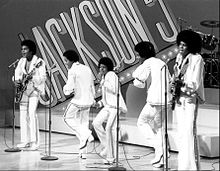
Jackson (center) as a member of the Jackson 5 in 1972.
In 1964, Michael and Marlon joined the Jackson Brothers—a band formed by their father and which included brothers Jackie, Tito, and Jermaine—as backup musicians playing congas and tambourine.[41] In 1965, Jackson began sharing lead vocals with his older brother Jermaine, and the group’s name was changed to the Jackson 5.[27] The following year, the group won a major local talent show with Jackson performing the dance to Robert Parker‘s 1965 hit “Barefootin’“.[42] From 1966 to 1968 the band toured the Midwest, frequently performing at a string of black clubs known as the “chitlin’ circuit” as the opening act for artists such as Sam & Dave, the O’Jays, Gladys Knight, and Etta James. The Jackson 5 also performed at clubs and cocktail lounges, where striptease shows and other adult acts were featured, and at local auditoriums and high school dances.[43][44] In August 1967, while touring the East coast, the group won a weekly amateur night concert at the Apollo Theater in Harlem.[45]
The Jackson 5 recorded several songs, including “Big Boy” (1968), their first single, for Steeltown Records, a Gary, Indiana, record label,[46] before signing with Motown in 1969.[27] They left Gary in 1969 and relocated to the Los Angeles area, where they continued to record music for Motown.[47] Rolling Stone later described the young Michael as “a prodigy” with “overwhelming musical gifts” who “quickly emerged as the main draw and lead singer.”[48] The group set a chart record when its first four singles—”I Want You Back” (1969), “ABC” (1970), “The Love You Save” (1970), and “I’ll Be There” (1970)—peaked at number one on the Billboard Hot 100.[27] In May 1971, the Jackson family moved into a large home on two-acre estate in Encino, California.[49] During this period, Michael evolved from child performer into a teen idol.[50] As Jackson began to emerge as a solo performer in the early 1970s, he maintained ties to the Jackson 5 and Motown. Between 1972 and 1975, Michael released four solo studio albums with Motown: Got to Be There (1972), Ben (1972), Music & Me (1973), andForever, Michael (1975).[51] “Got to Be There” and “Ben“, the title tracks from his first two solo albums, both became successful singles, as did a cover of Bobby Day‘s “Rockin’ Robin“.[52]
The Jackson 5 were later described as “a cutting-edge example of black crossover artists.”[53] Although the group’s sales began to decline in 1973, and the band members chafed under Motown’s refusal to allow them creative input, they achieved several top 40 hits, including the top five single “Dancing Machine” (1974), before leaving Motown in 1975.[54]
1975–1981: Move to Epic and Off the Wall
In June 1975, the Jackson 5 signed with Epic Records, a subsidiary of CBS Records,[54] and renamed themselves the Jacksons. Younger brother Randy formally joined the band around this time, while Jermaine chose to stay with Motown and pursue a solo career.[55] The Jacksons continued to tour internationally, and released six more albums between 1976 and 1984. Michael, the group’s lead songwriter during this time, wrote hits such as “Shake Your Body (Down to the Ground)” (1979), “This Place Hotel” (1980), and “Can You Feel It” (1980).[41]
His work in film began in 1978, when he starred as the Scarecrow in The Wiz, a musical directed by Sidney Lumet that also starred Diana Ross, Nipsey Russell, and Ted Ross.[56] The film was a box-office failure.[57] While working on the film Jackson met producer Quincy Jones, though this was not the first time they had met (they originally met when Michael was 12, at Sammy Davis Jr.‘s house).[58] Jones was arranging the film’s musical score and agreed to produce Jackson’s next solo album, Off the Wall.[59] In 1979, Jackson broke his nose during a complex dance routine. His subsequent rhinoplasty was not a complete success; he complained of breathing difficulties that would affect his career. He was referred to Dr. Steven Hoefflin, who performed Jackson’s second rhinoplasty and subsequent operations.[60]
Off the Wall (1979), which Jones and Jackson co-produced, established Jackson as a solo performer. The album helped Jackson transition from the bubblegum pop of his youth to the more complex sounds he would create as an adult.[50] Songwriters for the album included Jackson, Rod Temperton, Stevie Wonder, and Paul McCartney. Off the Wall was the first solo album to generate four top 10 hits in the United States: “Off the Wall”, “She’s Out of My Life“, and the chart-topping singles “Don’t Stop ‘Til You Get Enough” and “Rock with You“.[61][62] The album reached number three on the Billboard 200 and eventually sold over 20 million copies worldwide.[63] In 1980, Jackson won three awards at the American Music Awards for his solo efforts: Favorite Soul/R&B Album, Favorite Soul/R&B Male Artist, and Favorite Soul/R&B Single for “Don’t Stop ‘Til You Get Enough”.[64][65] He also won Billboard Year-End awards for Top Black Artist and Top Black Album, and a Grammy Award for Best Male R&B Vocal Performance for 1979 with “Don’t Stop ‘Til You Get Enough”.[66] In 1981 Jackson was the American Music Awards winner for Favorite Soul/R&B Album and Favorite Soul/R&B Male Artist.[67] Despite its commercial success, Jackson felt Off the Wall should have made a bigger impact, and was determined to exceed expectations with his next release.[68] In 1980, he secured the highest royalty rate in the music industry: 37 percent of wholesale album profit.[69]
Jackson recorded with Queen singer Freddie Mercury from 1981 to 1983, including a demo of “State of Shock“, “Victory” and “There Must Be More to Life Than This”.[70] The recordings were intended for an album of duets but, according to Queen’s then-manager Jim Beach, the relationship between the singers soured when Jackson insisted on bringing a llama into the recording studio.[71] The collaborations were not officially released until 2014.[72] Jackson went on to record the single “State of Shock” with Mick Jaggerfor the Jacksons‘ album Victory (1984).[73] Mercury included the solo version of “There Must Be More To Life Than This” on his Mr. Bad Guy album (1985).[74]
1982–1983: Thriller and Motown 25: Yesterday, Today, Forever
In 1982, Jackson combined his interests in songwriting and film when he contributed the song “Someone in the Dark” to the storybook for the film E.T. the Extra-Terrestrial. The song, with Quincy Jones as its producer, won a Grammy for Best Recording for Children for 1983.[75]
More success came with the release of his sixth album, Thriller, in late 1982. The album earned Jackson seven more Grammys[75] and eight American Music Awards, including the Award of Merit, the youngest artist to win it.[76] It was the best-selling album worldwide in 1983,[77][78] and became the best-selling album of all time in the United States[79]and the best-selling album of all time worldwide, selling an estimated 65 million copies.[80] It topped the Billboard 200 chart for 37 weeks and was in the top 10 of the 200 for 80 consecutive weeks. It was the first album to have seven Billboard Hot 100 top 10 singles, including “Billie Jean“, “Beat It“, and “Wanna Be Startin’ Somethin’“.[81] In December 2015, Thriller was certified for 30 million shipments by the RIAA, making it the only album to achieve that feat in the United States.[82] Thriller won Jackson and Quincy Jones the Grammy award for Producer of the Year (Non-Classical) for 1983. It also won Album of the Year, with Jackson as the album’s artist and Jones as its co-producer, and a Best Pop Vocal Performance, Male, award for Jackson. “Beat It” won Record of the Year, with Jackson as artist and Jones as co-producer, and a Best Rock Vocal Performance, Male, award for Jackson. “Billie Jean” won Jackson two Grammy awards, Best R&B Song, with Jackson as its songwriter, and Best R&B Vocal Performance, Male, as its artist.[75]Thriller also won another Grammy for Best Engineered Recording – Non Classical in 1984, awarding Bruce Swedien for his work on the album.[83] The AMA Awards for 1984 provided Jackson with an Award of Merit and AMAs for Favorite Male Artist, Soul/R&B, and Favorite Male Artist, Pop/Rock. “Beat It” won Jackson AMAs for Favorite Video, Soul/R&B, Favorite Video, Pop/Rock, and Favorite Single, Pop/Rock. Thriller won him AMAs for Favorite Album, Soul/R&B, and Favorite Album, Pop/Rock.[76][84]
In addition to the album, Jackson released “Thriller“, a 14-minute music video directed by John Landis, in 1983.[85] It “defined music videos and broke racial barriers” on the Music Television Channel (MTV), a fledgling entertainment television channel at the time.[50] In December 2009, the Library of Congress selected the “Thriller” music video for inclusion in the National Film Registry. It was one of 25 films named that year as “works of enduring importance to American culture” that would be “preserved for all time.”[86][87]As of 2009, the zombie-themed “Thriller” is the only music video to have been inducted into the registry.[85][87][88]
Jackson’s attorney John Branca noted that Jackson had the highest royalty rate in the music industry at that point: approximately $2 for every album sold. He was also making record-breaking profits from sales of his recordings. The videocassette of the documentary The Making of Michael Jackson’s Thriller sold over 350,000 copies in a few months. The era saw the arrival of novelties such as dolls modeled after Michael Jackson, which appeared in stores in May 1984 at a price of $12.[89] Biographer J. Randy Taraborrelli writes that “Thriller stopped selling like a leisure item—like a magazine, a toy, tickets to a hit movie—and started selling like a household staple.”[90]In 1985, The Making of Michael Jackson’s Thriller won a Grammy for Best Music Video, Longform.[75] Time described Jackson’s influence at that point as “star of records, radio, rock video. A one-man rescue team for the music business. A songwriter who sets the beat for a decade. A dancer with the fanciest feet on the street. A singer who cuts across all boundaries of taste and style and color too”.[89] The New York Times wrote that “in the world of pop music, there is Michael Jackson and there is everybody else”.[91]
On March 25, 1983, Jackson reunited with his brothers for a live performance taped at the Pasadena Civic Auditorium for Motown 25: Yesterday, Today, Forever, an NBC television special. The show aired on May 16, 1983, to an estimated audience of 47 million viewers, and featured the Jacksons and other Motown stars.[92] The show is best remembered for Jackson’s solo performance of “Billie Jean”, which earned Jackson his first Emmy nomination.[93] Wearing a distinctive black-sequined jacket and a golf glove decorated withrhinestones, he debuted his signature dance move, the moonwalk, which former Soul Train dancer and Shalamar member Jeffrey Danielhad taught him three years earlier.[94] Jackson originally turned down the invitation to perform at the show, believing he had been doing too much television at the time; however, at the request of Berry Gordy, Jackson agreed to perform in exchange for time to do a solo performance.[95] According to Rolling Stone reporter Mikal Gilmore, “There are times when you know you are hearing or seeing something extraordinary…that came that night.”[50] Jackson’s performance drew comparisons to Elvis Presley‘s and the Beatles‘ appearances on The Ed Sullivan Show.[96] Anna Kisselgoff of The New York Times later wrote: “The moonwalk that he made famous is an apt metaphor for his dance style. How does he do it? As a technician, he is a great illusionist, a genuine mime. His ability to keep one leg straight as he glides while the other bends and seems to walk requires perfect timing.”[97] Berry Gordy said of the performance, “from the first beat of Billie Jean, I was mesmerized, and when he did his iconic moonwalk, I was shocked, it was magic, Michael Jackson went into orbit, and never came down.”[98]
1984–1985: Pepsi, “We Are the World”, and business career
In November 1983 Jackson and his brothers partnered with PepsiCo in a $5 million promotional deal that broke advertising industry records for a celebrity endorsement. The first Pepsi Cola campaign, which ran in the United States from 1983 to 1984 and launched its “New Generation” theme, included tour sponsorship, public relations events, and in-store displays. Jackson, who was actively involved in creating the iconic advertisement, suggested using his song, “Billie Jean”, as its jingle with a revised chorus.[99] According to a Billboard report in 2009, Brian J. Murphy, executive VP of branded management at TBA Global, said: “You couldn’t separate the tour from the endorsement from the licensing of the music, and then the integration of the music into the Pepsi fabric.”[99]
On January 27, 1984, Michael and other members of the Jacksons filmed a Pepsi commercial overseen by executive Phil Dusenberry,[100] a BBDO ad agency executive, andAlan Pottasch, Pepsi’s Worldwide Creative Director, at the Shrine Auditorium in Los Angeles. During a simulated concert before a full house of fans, pyrotechnics accidentally set Jackson’s hair on fire, causing second-degree burns to his scalp. Jackson underwent treatment to hide the scars and had his third rhinoplasty shortly thereafter.[60] Pepsi settled out of court, and Jackson donated his $1.5 million settlement to the Brotman Medical Center in Culver City, California. Its Michael Jackson Burn Center is named in his honor.[101]Dusenberry later recounted the episode in his memoir, Then We Set His Hair on Fire: Insights and Accidents from a Hall of Fame Career in Advertising. Jackson signed a second agreement with Pepsi in the late 1980s for a reported $10 million. The second campaign had a global reach of more than 20 countries and would provide financial support for Jackson’s Bad album and 1987–88 world tour.[99] Although Jackson had endorsements and advertising deals with other companies, such as LA Gear, Suzuki, andSony, none were as significant as his deals with Pepsi, which later signed other music stars such as Britney Spears and Beyoncé to promote its products.[99][102]
Jackson’s humanitarian work was recognized on May 14, 1984, when he was invited to the White House to receive an award from President Ronald Reagan for his support of charities that helped people overcome alcohol and drug abuse,[103] and in recognition of his support for the Ad Council‘s and the National Highway Traffic Safety Administration‘s Drunk Driving Prevention campaign. Jackson donated the use of “Beat It” for the campaign’s public service announcements.[104]
Unlike later albums, Thriller did not have an official tour, but the Victory Tour of 1984 headlined the Jacksons and showcased much of Jackson’s new solo material to more than two million Americans. It was the last tour he would do with his brothers.[105] Following controversy over the concert’s ticket sales, Jackson held a press conference and announced that he would donate his share of the proceeds, an estimated $3 to 5 million, to charity.[106][107] His charitable work and humanitarian awards continued with the release of “We Are the World” (1985), which he co-wrote with Lionel Richie.[108] The song was recorded on January 28, 1985[109] and was released worldwide in March 1985 to aid the poor in the United States and Africa.[110] The song earned $63 million for famine relief,[110] and became one of the best-selling singles of all time, with 20 million copies sold.[111] “We Are the World” won four Grammys for 1985, including Song of the Year going to Jackson and Richie as its co-songwriters.[108] Although the American Music Award directors removed the charity song from the competition because they felt it would be inappropriate, the AMA show in 1986 concluded with a tribute to the song in honor of its first anniversary. The project’s creators received two special AMA honors: one for the creation of the song and another for the USA for Africa idea. Jackson, Quincy Jones, and entertainment promoter Ken Kragan received special awards for their roles in the song’s creation.[108][109][112][113]
Jackson’s financial interests in the music publishing business grew after Jackson collaborated with Paul McCartney in the early 1980s. He subsequently learned that McCartney was making approximately $40 million a year from other people’s songs.[110] By 1983, Jackson had begun investing in publishing rights to songs that others had written, but he was careful with his acquisitions, only bidding on a few of the dozens that were offered to him. Jackson’s early acquisitions of music catalogs and song copyrights such as the Sly Stone collection included “Everyday People” (1968), Len Barry‘s “1-2-3” (1965), and Dion DiMucci‘s “The Wanderer” (1961) and “Runaround Sue” (1961); however, Jackson’s most significant purchase came in 1985, when he acquired the publishing rights to ATV Music Publishing after months of negotiation.[110] ATV had acquired the publishing rights to nearly 4000 songs, including the Northern Songs catalog that contained the majority of the Lennon–McCartney compositions recorded by the Beatles.[114]
In 1984 Robert Holmes à Court, the wealthy Australian investor who owned ATV Music Publishing, announced he was putting the ATV catalog up for sale.[114] In 1981, McCartney was offered the ATV music catalog for £20 million ($40 million).[110][115][116] According to McCartney, he contacted Yoko Ono about making a joint purchase by splitting the cost at £10 million each, but Ono thought they could buy it for £5 million each.[110][116] When they were unable to make a joint purchase, McCartney, who did not want to be the sole owner of the Beatles’ songs, did not pursue an offer on his own.[115][116] According to a negotiator for Holmes à Court in the 1984 sale, McCartney was given first right of refusal and declined to purchase.[117]
Jackson was informed of the sale by his attorney, John Branca, in September 1984.[114] An attorney for McCartney also assured Branca that McCartney was not interested in bidding. McCartney reportedly felt it was too expensive,[110][115] but several other companies and investors were interested in bidding. Jackson submitted a bid of $46 million on November 20, 1984.[114] His agents thought they had a deal several times, but encountered new bidders or new areas of debate. In May 1985, Jackson’s team left talks after having spent more than $1 million and four months of due diligence work on the negotiations.[114] In June 1985, Jackson and Branca learned that Charles Koppelman‘s andMarty Bandier‘s The Entertainment Company had made a tentative agreement with Holmes à Court to buy ATV Music for $50 million; however, in early August, Holmes à Court’s team contacted Jackson and talks resumed. Jackson raised his bid to $47.5 million, which was accepted because he could close the deal more quickly, having already completed due diligence of ATV Music.[114] Jackson also agreed to visit Holmes à Court in Australia, where he would appear on the Channel Seven Perth Telethon.[117] Jackson’spurchase of ATV Music was finalized on August 10, 1985.[114]
1986–1990: Changing appearance, tabloids, Bad, films, autobiography, and Neverland
Jackson’s skin had been a medium-brown color during his youth, but starting in the mid-1980s gradually grew paler. The change gained widespread media coverage, including rumors that he might have been bleaching his skin.[118] According to J. Randy Taraborrelli‘s biography, in 1984, Jackson was diagnosed with vitiligo, which Taraborrelli noted may be a consequence of skin bleaching. He claimed Jackson was diagnosed with lupus. The vitiligo partially lightened his skin, and the lupus was in remission. Both illnesses made his skin sensitive to sunlight. The treatments Jackson used for his condition further lightened his skin tone, and with the application of pancake makeup to even out blotches he could appear pale.[119] Jackson was also diagnosed with vitiligo in his autopsy, though not lupus.[120]
Jackson claimed he had only two rhinoplasties and no other facial surgery, although at one point mentioned having a dimple created in his chin. He lost weight in the early 1980s because of a change in diet and a desire for “a dancer’s body”.[121] Witnesses reported that he was often dizzy, and speculated he was suffering from anorexia nervosa. Periods of weight loss would become a recurring problem later in life.[122] During the course of his treatment, Jackson made two close friends: his dermatologist, Dr. Arnold Klein, and Klein’s nurse Debbie Rowe. Rowe eventually became Jackson’s second wife and the mother of his two eldest children. He also relied heavily on Klein for medical and business advice.[123]
Jackson became the subject of increasingly sensational reports. In 1986, the tabloids ran a story claiming that Jackson slept in a hyperbaric oxygen chamber to slow the aging process; he was pictured lying in a glass box. Although the claim was untrue, according to tabloid reports that are widely cited, Jackson had disseminated the fabricated story himself.[124] When Jackson bought a chimpanzee named Bubbles from a laboratory, he was reported to be increasingly detached from reality.[125] It was reported that Jackson had offered to buy the bones of Joseph Merrick (the “Elephant Man”) and, although untrue, Jackson did not deny the story.[126] Although he initially saw these stories as opportunities for publicity, he stopped leaking untruths to the press as they became more sensational. Consequently, the media began fabricating stories.[124][127][128] These reports became embedded in the public consciousness, inspiring the nickname “Wacko Jacko”, which Jackson came to despise.[4][129] Responding to the gossip, Jackson remarked to Taraborrelli:
Why not just tell people I’m an alien from Mars? Tell them I eat live chickens and do a voodoo dance at midnight. They’ll believe anything you say, because you’re a reporter. But if I, Michael Jackson, were to say, “I’m an alien from Mars and I eat live chickens and do a voodoo dance at midnight,” people would say, “Oh, man, that Michael Jackson is nuts. He’s cracked up. You can’t believe a single word that comes out of his mouth.”[130]

Jackson wore a gold-plated military style jacket with belt during the Bad era.
Jackson collaborated with filmmakers George Lucas and Francis Ford Coppola on the 17-minute 3D film Captain EO, which debuted in September 1986 at both the original Disneyland and at Epcot in Florida, and in March 1987 at Tokyo Disneyland. The $30 million movie was a popular attraction at all three parks. A Captain EO attraction was later featured at Euro Disneyland after that park opened in 1992. All four parks’ Captain EO installations stayed open well into the 1990s: the Paris installation was the last to close, in 1998.[131] The attraction would later return to Disneyland in 2010 after Jackson’s death.[132] In 1987, Jackson disassociated himself from the Jehovah’s Witnesses, in response to their disapproval of the Thriller video.[133][134]
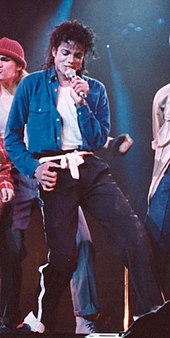
Jackson performing in 1988.
With the industry expecting another major hit, Jackson’s first album in five years, Bad (1987), was highly anticipated.[135] The album produced nine singles: seven of them were successful in the U.S., and only two of them were failures. Five of these singles (“I Just Can’t Stop Loving You“, “Bad“, “The Way You Make Me Feel“, “Man in the Mirror“, and “Dirty Diana“) reached number one on the Billboard Hot 100. This was a record for most number one Hot 100 singles from any one album, including Thriller.[136] As of 2012, the album had sold between 30 and 45 million copies worldwide.[137][138][139][140] Bruce Swedien and Humberto Gatica won one Grammy in 1988 for Best Engineered Recording – Non Classical and Michael Jackson won one Grammy for Best Music Video, Short Form for “Leave Me Alone” in 1989.[75][83] In the same year, Jackson won an Award of Achievement at the American Music Awards because Bad is the first album ever to generate five number one singles in the U.S., the first album to top in 25 countries, and the best-selling album worldwide in 1987 and 1988.[141][142][143][144] In 1988, “Bad” won an American Music Award for Favorite Soul/R&B Single.[145]
The Bad World Tour began on September 12 that year, finishing on January 14, 1989.[146] In Japan alone, the tour had 14 sellouts and drew 570,000 people, nearly tripling the previous record of 200,000 in a single tour.[147] Jackson broke a Guinness World Record when 504,000 people attended seven sold-out shows at Wembley Stadium.[148] He performed a total of 123 concerts to an audience of 4.4 million people.[149]
In 1988, Jackson released his only autobiography, Moonwalk, which took four years to complete and sold 200,000 copies.[150] He wrote about his childhood, the Jackson 5, and the abuse he had suffered.[151] He also wrote about his changing facial appearance, attributing it to puberty, weight loss, a strict vegetarian diet, a change in hair style, and stage lighting.[121] Moonwalk reached the top position on The New York Timesbest sellers’ list.[152] Jackson released a film, Moonwalker, which featured live footage and short films starring Jackson and Joe Pesci. Due to financial issues, the film was only released theatrically in Germany; in other markets it was released direct-to-video. It debuted at the top of theBillboard Top Music Video Cassette chart, staying there for 22 weeks. It was eventually knocked off the top spot by Michael Jackson: The Legend Continues.[153]
In March 1988, Jackson purchased land near Santa Ynez, California, to build Neverland Ranch at a cost of $17 million.[154] He installed several carnival rides on the 2,700-acre (11 km2) property, including a Ferris wheel, carousel, menagerie, as well as a movie theater and a zoo.[154][155][156] A security staff of 40 patrolled the grounds.[155] In 2003, it was valued at approximately $100 million.[157] In 1989, Jackson’s annual earnings from album sales, endorsements, and concerts were estimated at $125 million for that year alone.[158] Shortly afterwards, he became the first Westerner to appear in a television ad in the Soviet Union.[153]
Jackson’s success resulted in him being dubbed the “King of Pop“.[8][9][10] The nickname was popularized by Elizabeth Taylor when she presented him with the Soul Train Heritage Award in 1989, proclaiming him “the true king of pop, rock and soul.”[159] President George H. W. Bush designated him the White House’s “Artist of the Decade”.[160]From 1985 to 1990, he donated $455,000 to the United Negro College Fund,[161] and all profits from his single “Man in the Mirror” went to charity.[162] Jackson’s live rendition of “You Were There” at Sammy Davis Jr.‘s 60th birthday celebration won Jackson a second Emmy nomination.[93][153]
1991–1993: Dangerous, Heal the World Foundation, and Super Bowl XXVII
In March 1991, Jackson renewed his contract with Sony for $65 million, a record-breaking deal at the time,[163] displacing Neil Diamond‘s renewal contract with Columbia Records.[164] In 1991, he released his eighth album, Dangerous, co-produced with Teddy Riley.[165] Dangerous was certified seven times platinum in the U.S., and by 2008 had sold approximately 30 million copies worldwide.[166][167] In the United States, the album’s first single “Black or White” was its biggest hit, reaching number one on the BillboardHot 100 and remaining there for seven weeks, with similar chart performances worldwide.[168] The album’s second single, “Remember the Time“, spent eight weeks in the top five in the United States, peaking at number three on the Billboard Hot 100 singles chart.[169] At the end of 1992, Dangerous was awarded the best-selling album of the year worldwide and “Black or White” was awarded best-selling single of the year worldwide at the Billboard Music Awards. Jackson also won an award as best-selling artist of the 1980s.[170] In 1993, he performed the song at the Soul Train Music Awards in a chair, saying he had suffered an injury in rehearsals.[171] In the UK and other parts of Europe, “Heal the World” was the album’s most successful song; it sold 450,000 copies in the UK and spent five weeks at number two in 1992.[169]
Jackson founded the Heal the World Foundation in 1992. The charity organization brought underprivileged children to Jackson’s ranch to enjoy theme park rides that Jackson had built on the property. The foundation also sent millions of dollars around the globe to help children threatened by war, poverty, and disease. In the same year, Jackson published his second book, Dancing the Dream, a collection of poetry, revealing a more intimate side of his nature. While it was a commercial success, it received mostly negative reviews. In 2009, the book was republished by Doubleday and was more positively received by some critics in the wake of Jackson’s death. The Dangerous World Tourgrossed $100 million. The tour began on June 27, 1992, and finished on November 11, 1993. Jackson performed to 3.5 million people in 70 concerts.[169][172] He sold the broadcast rights to his Dangerous world tour to HBO for $20 million, a record-breaking deal that still stands.[173]
Following the illness and death of AIDS spokesperson Ryan White, Jackson helped draw public attention to HIV/AIDS, something that was controversial at the time. He publicly pleaded with the Clinton Administration at Bill Clinton’s Inaugural Gala to give more money to HIV/AIDS charities and research.[174][175] In a high-profile visit to Africa, Jackson visited several countries, among them Gabon and Egypt.[176] His first stop to Gabon was greeted with an enthusiastic reception of more than 100,000 people, some of them carrying signs that read, “Welcome Home Michael.”[176] In his trip to Ivory Coast, Jackson was crowned “King Sani” by a tribal chief.[176] He thanked the dignitaries in French and English, signed official documents formalizing his kingship, and sat on a golden throne while presiding over ceremonial dances.[176]
In January 1993, Jackson performed at the Super Bowl XXVII halftime show in Pasadena, California. Because of a dwindling interest during halftime in the preceding years, the NFL decided to seek big-name talent that would keep ratings high, with Jackson selected for his universal appeal.[177] It was the first Super Bowl whose half-time performance drew greater audience figures than the game itself. The performance began with Jackson catapulting onto the stage as fireworks went off behind him. As he landed on the canvas, he maintained a “clenched fist, standing statue stance,” dressed in a gold and black military outfit and sunglasses; he remained completely motionless for a minute and a half while the crowd cheered. He then slowly removed his sunglasses, threw them away, and performed four songs: “Jam“, “Billie Jean”, “Black or White”, and “Heal the World”. Jackson’s Dangerous album rose 90 places up the album chart soon after.[118]
Jackson gave a 90-minute interview to Oprah Winfrey on February 10, 1993, his second television interview since 1979. He grimaced when speaking of his childhood abuse at the hands of his father; he believed he had missed out on much of his childhood years, admitting that he often cried from loneliness. He denied tabloid rumors that he had bought the bones of the Elephant Man, slept in a hyperbaric oxygen chamber, or bleached his skin, stating for the first time that he had vitiligo. Dangerous re-entered the album chart in the top 10, more than a year after its original release.[34][118][169]
In February 1993, Jackson was given the “Living Legend Award” at the 35th Annual Grammy Awards in Los Angeles. “Black or White” was Grammy-nominated for best vocal performance. “Jam” gained two nominations: Best R&B Vocal Performance and Best R&B Song.[169] The Dangerous album won a Grammy for Best Engineered – Non Classical, awarding the work of Bruce Swedien and Teddy Riley.[83] In the same year, Michael Jackson won three American Music Awards for Favorite Pop/Rock Album (Dangerous), Favorite Soul/R&B Single (“Remember the Time“), and was the first to win the International Artist Award of Excellence, for his global performances and humanitarian concerns.[178][179]
Jackson agreed to produce the soundtrack for Sega‘s 1994 video game Sonic the Hedgehog 3 with collaborators Brad Buxer, Bobby Brooks, Darryl Ross, Geoff Grace, Doug Grigsby, and Cirocco Jones.[180][181][182] Jackson left the project before completion and was never officially credited, allegedly due to his dissatisfaction with the Sega Genesisconsole’s audio chip.[183][184][185]
1993–1994: First child sexual abuse allegations and first marriage
In the summer of 1993, Jackson was accused of child sexual abuse by a 13-year-old boy named Jordan Chandler and his father, Evan Chandler, a dentist.[186][187][188] The Chandler family demanded payment from Jackson, and the singer initially refused. Jordan Chandler eventually told the police that Jackson had sexually abused him.[126][189]Evan Chandler was recorded discussing his intention to pursue charges, saying, “If I go through with this, I win big-time. There’s no way I lose. I will get everything I want and they will be destroyed forever….. Michael’s career will be over.” Jordan’s mother was, however, adamant at the time that there had been no wrongdoing on Jackson’s part.[188]Jackson later used the recording to argue that he was the victim of a jealous father whose only goal was to extort money from the singer.[188] In January 1994, after investigation on allegations of extortion against the singer by Chandler, deputy Los Angeles County district attorney Michael J. Montagna stated that Chandler would not be charged, due to lack of cooperation from Jackson’s party and its willingness to negotiate with Chandler for several weeks, among other reasons.[190]
In August 1993, Jackson’s home was raided by the police who, according to court documents, found books and photographs in his bedroom featuring young boys with little or no clothing.[191] Since the books were legal to purchase and own, the jury decided not to indict Jackson.[192] In December 1993, Jackson was strip-searched.[193] Jordan Chandler had reportedly given police a description of Jackson’s intimate parts, and the strip search revealed that Jordan had correctly claimed Jackson had patchy-colored buttocks, shortpubic hair, and pink and brown marked testicles.[193] Reportedly, Jordan had also previously drawn accurate pictures of a dark spot on Jackson’s penis only visible when his penis was lifted.[194] Despite differing initial internal reports from prosecutors and investigators[195] and later, with reports of jurors feeling otherwise that the photos did not match the description,[196] the DA stated his belief in a sworn affidavit that the description was accurate,[197] along with the sheriff’s photographer stating the description was accurate.[198] A 2004 motion filed by Jackson’s defense asserted that Jackson was never criminally indicted by any grand jury and that his settlement admitted no wrongdoing and contained no evidence of criminal misconduct.[199]
The investigation was inconclusive and no charges were filed.[196] Jackson described the search in an emotional public statement, and proclaimed his innocence.[186][193][200] On January 1, 1994, Jackson settled with the Chandlers out of court for $22 million. A Santa Barbara County grand jury and a Los Angeles County grand jury disbanded on May 2, 1994, without indicting Jackson,[201] and the Chandlers stopped co-operating with the criminal investigation around July 6, 1994.[199][202][203] The out-of-court settlement’s documentation stated Jackson admitted no wrongdoing and no liability; the Chandlers and their family lawyer Larry Feldman signed it without contest.[204]
Feldman also stated “nobody bought anybody’s silence”.[205] A decade after the fact, during the second round of child abuse allegations, Jackson’s lawyers would file a memo stating that the 1994 settlement was done without his consent.[199] A later disclosure by the FBI of investigation documents compiled over nearly 20 years led Jackson’s attorney to suggest that no evidence of molestation or sexual impropriety from Jackson toward minors existed.[206] According to reports the Department of Children and Family Services (Los Angeles County) had investigated Jackson beginning in 1993 with the Chandler allegation and again in 2003. Reports show the LAPD and DCFS did not find credible evidence of abuse or sexual misconduct.[207][208][209]
In May 1994, Jackson married Lisa Marie Presley, the daughter of Elvis and Priscilla Presley. They had met in 1975, when a seven-year-old Presley attended one of Jackson’s family engagements at the MGM Grand Hotel and Casino, and reconnected through a mutual friend.[210] According to a friend of Presley’s, “their adult friendship began in November 1992 in L.A.”[211] They stayed in contact every day over the telephone. As the child molestation accusations became public, Jackson became dependent on Presley for emotional support; she was concerned about his faltering health and addiction to drugs.[212] Presley explained, “I believed he didn’t do anything wrong and that he was wrongly accused and yes I started falling for him. I wanted to save him. I felt that I could do it.”[213] She eventually persuaded him to settle the civil case out of court and go into rehabilitation to recover.[212]
Jackson proposed to Presley over the telephone towards the fall of 1993, saying, “If I asked you to marry me, would you do it?”[212] They married in the Dominican Republic in secrecy, denying it for nearly two months afterwards.[214] The marriage was, in her words, “a married couple’s life … that was sexually active.”[215] The tabloid media speculated that the wedding was a ploy to prop up Jackson’s public image.[214] The marriage ended less than two years later with an amicable divorce settlement.[216] In a 2010 interview with Oprah, Presley admitted that they had spent four more years after the divorce “getting back together and breaking up” until she decided to stop.[217]
1995–1999: HIStory, second marriage, and fatherhood
In 1995, Jackson merged his ATV Music catalog with Sony’s music publishing division, creating Sony/ATV Music Publishing. He retained ownership of half the company, earning $95 million up front as well as the rights to more songs.[218][219] In June, he released the double album HIStory: Past, Present and Future, Book I. The first disc, HIStory Begins, is a 15-track greatest hits album (later reissued as Greatest Hits: HIStory, Volume I in 2001); the second disc, HIStory Continues, contains 13 original songs and 2 cover versions. The album debuted at number one on the charts and has been certified for seven million shipments in the US.[220] It is the best-selling multiple-disc album of all-time, with 20 million copies (40 million units) sold worldwide.[168][221] HIStory received a Grammy nomination for Album of the Year.[222]
The first single released from the album was “Scream/Childhood“. “Scream”, a duet with Jackson’s youngest sister Janet, protests the media, particularly for its treatment of him during the 1993 child abuse allegations. The single had the highest debut on the Billboard Hot 100 at number five, and received a Grammy nomination for “Best Pop Collaboration with Vocals”.[222] “You Are Not Alone” was the second single released from HIStory; it holds the Guinness World Record for the first song ever to debut at number one on the Billboard Hot 100 chart.[158] It was seen as a major artistic and commercial success, receiving a Grammy nomination for “Best Pop Vocal Performance”.[222]
In late 1995, Jackson was rushed to a hospital after collapsing during rehearsals for a televised performance, caused by a stress-related panic attack.[223] “Earth Song” was the third single released from HIStory, and topped the UK Singles Chart for six weeks over Christmas 1995; it sold a million copies, making it Jackson’s most successful single in the UK.[222] The track “They Don’t Care About Us” became controversial when theAnti-Defamation League and other groups criticized its allegedly antisemitic lyrics. Jackson quickly released a revised version of the song without the offending lyrics.[224] In 1996, Jackson won a Grammy for Best Music Video, Short Form for “Scream” and an American Music Award for Favorite Pop/Rock Male Artist.[75][225]
HIStory was promoted with the successful HIStory World Tour, beginning on September 7, 1996, and ending on October 15, 1997. Jackson performed 82 concerts in five continents, 35 countries and 58 cities to over 4.5 million fans, and grossed a total of $165 million, becoming Jackson’s most successful tour in terms of audience figures.[146] During the tour, Jackson married his longtime friend Deborah Jeanne Rowe, a dermatology nurse, in an impromptu ceremony in Sydney, Australia. Rowe was approximately six months pregnant with the couple’s first child at the time. Originally, Rowe and Jackson had no plans to marry, but Jackson’s mother Katherine persuaded them to do so.[226] Michael Joseph Jackson Jr (commonly known as Prince) was born on February 13, 1997; his sister Paris-Michael Katherine Jackson was born a year later on April 3, 1998.[216][227] The couple divorced in 1999, and Jackson received full custody of the children. The divorce was relatively amicable, but a subsequent custody suit was not settled until 2006.[228][229]
In 1997, Jackson released Blood on the Dance Floor: HIStory in the Mix, which contained remixes of hit singles from HIStory and five new songs. Worldwide sales stand at 6 million copies, making it the best-selling remix album of all time.[230] It reached number one in the UK, as did the title track.[230][231] In the US, the album was certified platinum, but only reached number 24.[166][222] Forbes placed Jackson’s annual income at $35 million in 1996 and $20 million in 1997.[157]
Throughout June 1999, Jackson was involved in a number of charitable events. He joined Luciano Pavarotti for a benefit concert in Modena, Italy. The show was in support of the nonprofit organization War Child, and raised a million dollars for the refugees of Kosovo, FR Yugoslavia, and additional funds for the children of Guatemala.[232] Later that month, Jackson organized a series of “Michael Jackson & Friends” benefit concerts in Germany and Korea. Other artists involved included Slash, The Scorpions, Boyz II Men,Luther Vandross, Mariah Carey, A. R. Rahman, Prabhu Deva Sundaram, Shobana, Andrea Bocelli, and Luciano Pavarotti. The proceeds went to the Nelson Mandela Children’s Fund, the Red Cross and UNESCO.[233] From August 1999 through 2000, he lived in New York City at 4 East 74th Street.[234]
2000–2003: Label dispute and Invincible
At the turn of the century, Jackson won an American Music Award as Artist of the 1980s.[235] Throughout 2000 and 2001, he worked with collaborators including Teddy Riley andRodney Jerkins to produce his tenth solo album, Invincible, released in October 2001. The album cost $30 million to record, not including promotional expenditures.[236]Invincible was Jackson’s first full-length album in six years, and was the last album of original material he released in his lifetime. The release was preceded by a dispute between Jackson and his record label, Sony Music Entertainment. Jackson had expected the licenses to the masters of his albums to revert to him sometime in the early 2000s. Once he had the licenses, he would be able to promote the material however he pleased and keep all the profits; however, clauses in the contract set the revert date years into the future. Jackson discovered that the attorney who had represented him in the deal had also been representing Sony.[231] Jackson was also concerned about the fact that for years, Sony had been pressuring him to sell his share in its music catalog venture. Jackson feared that Sony might have a conflict of interest, since if Jackson’s career failed, he would have to sell his share of the catalog at a low price.[237] Jackson sought an early exit from his contract.[231]
In September 2001, two 30th Anniversary concerts were held at Madison Square Garden to mark Jackson’s 30th year as a solo artist. Jackson appeared onstage alongside his brothers for the first time since 1984. The show also featured performances by Mýa, Usher, Whitney Houston, NSYNC, Destiny’s Child, Monica, Luther Vandross, and Slash, among other artists.[238] The second of the two shows took place the night before the September 11, 2001, terrorist attacks.[239] After 9/11, Jackson helped organize the United We Stand: What More Can I Give benefit concert at RFK Stadium in Washington, D.C. The concert took place on October 21, 2001, and included performances from dozens of major artists, including Jackson, who performed his song “What More Can I Give” as the finale.[237] Due to contractual issues related to the earlier 30th Anniversary concerts, later edited into a two-hour TV special titled Michael Jackson: 30th Anniversary Celebration broadcast in November 2001, Jackson’s solo performances were omitted from the televised benefit concert, although he could still be seen singing background vocals.
Invincible was released in October 2001 to much anticipation. It debuted at number one in 13 countries and went on to sell approximately 13 million copies worldwide. It received double-platinum certification in the U.S.[166][168] However, sales for Invincible were lower than Jackson’s previous releases, due in part to the record label dispute and the lack of promotion or tour, and its release at a bad time[240] for the music industry in general.[237] Invincible spawned three singles, “You Rock My World“, “Cry“, and “Butterflies“, the latter without a music video. Jackson alleged in July 2002 that the-then Sony Music chairman Tommy Mottola was a “devil” and a “racist” who did not support his African-American artists, using them merely for his own personal gain.[237] He charged that Mottola had called his colleague Irv Gotti a “fat nigger“.[241] Sony refused to renew Jackson’s contract, and claimed that a $25 million promotional campaign had failed because Jackson refused to tour in the United States.[236]
In 2002, Michael Jackson won his 22nd American Music Award for Artist of the Century.[242] In the same year, his third child, Prince Michael Jackson II (nicknamed “Blanket”) was born.[243] The mother’s identity was not announced, but Jackson said the child was the result of artificial insemination from a surrogate mother and his own sperm.[228] On November 20 of that year, Jackson brought his infant son onto the balcony of his room at the Hotel Adlon in Berlin as fans stood below, holding him in his right arm, with a cloth loosely draped over the baby’s face. The baby was briefly extended over a railing, four stories above ground level, prompting widespread criticism in the media. Jackson later apologized for the incident, calling it “a terrible mistake”.[244] In November 2003, Sony released Number Ones, a compilation of Jackson’s hits on CD and DVD. In the U.S., the album was certified triple platinum by the RIAA; in the UK it was certified six times platinum for shipments of at least 1.2 million units.[166][245]
2003–2005: Second child sexual abuse allegations and acquittal

Jackson in Las Vegas, 2003.
Beginning in May 2002, Jackson allowed a documentary film crew, led by British TV personality Martin Bashir, to follow him around nearly everywhere he went. Bashir’s film crew was with Jackson during the “baby-dangling incident” in Berlin. The program was broadcast in March 2003 as Living with Michael Jackson. In a particularly controversial scene, Jackson was seen holding hands and discussing sleeping arrangements with a young boy.[246]
As soon as the documentary aired, the Santa Barbara county attorney’s office began a criminal investigation. After an initial probe from the LAPD and DCFS was conducted in February 2003, they had initially concluded that molestation allegations were “unfounded” at the time.[209] After the young boy involved in the documentary and his mother had told investigators that Jackson had behaved improperly with the boy, Jackson was arrested in November 2003, and was charged with seven counts of child molestation and two counts ofadministering an intoxicating agent in relation to the 13-year-old boy shown in the film.[246] Jackson denied the allegations, saying the sleepovers were not sexual in nature. The People v. Jackson trial began on January 31, 2005, in Santa Maria, California, and lasted five months, until the end of May. On June 13, 2005, Jackson was acquitted on all counts.[247][248][249] After the trial, in a highly publicized relocation he moved to the Persian Gulf island of Bahrain, as a guest of Sheikh Abdullah.[250] Bahrain was also where the family intended to send Jackson if he was convicted (though Jackson did not know about the plan), according to a statement by Jermaine Jackson printed in The Times of London in September 2011.[251]
2006–2009: Closure of Neverland, final years, and This Is It
In March 2006, the main house at the Neverland Ranch was closed as a cost-cutting measure.[252] There were numerous reports around that time that Jackson had been having financial problems. He had been delinquent on his repayments of a $270 million loan secured against his music-publishing holdings, even though those holdings were reportedly making him as much as $75 million a year.[253] Bank of America sold the debt to Fortress Investments. Sony reportedly proposed a restructuring deal which would give them a future option to buy half of Jackson’s stake in their jointly-owned publishing company, leaving Jackson with a 25% stake.[219] Jackson agreed to a Sony-backed refinancing deal in April 2006, although the details were not made public.[254] Jackson did not have a recording contract at the time. In early 2006, it was announced that Jackson had signed a contract with a Bahrain-based startup called Two Seas Records. However, nothing came of the deal, and the Two Seas CEO Guy Holmes later stated that the deal had never been finalized.[255][256]
Throughout 2006, Sony repackaged 20 singles from the 1980s and 1990s as the Michael Jackson: Visionary series, which subsequently became a box set. Most of those singles returned to the charts as a result. In September 2006, Jackson and his ex-wife Debbie Rowe confirmed reports that they had settled their long-running child custody suit. The terms were never made public. Jackson continued to be the custodial parent of the couple’s two children.[229] In October 2006, Fox News entertainment reporter Roger Friedman said that Jackson had been recording at a studio in rural Westmeath, Ireland. It was not known at the time what Jackson had working on, or who had paid for the sessions, since his publicist had recently issued a statement claiming that he had left Two Seas.[256][257]
In November 2006, Jackson invited an Access Hollywood camera crew into the studio in Westmeath, and MSNBC reported that he was working on a new album, produced by will.i.am.[168] Jackson performed at the World Music Awards in London on November 15, 2006, and accepted a Diamond Award for selling over 100 million records.[168][258] He returned to the United States after Christmas 2006 to attend James Brown‘s funeral in Augusta, Georgia, where he gave one of the eulogies, saying that “James Brown is my greatest inspiration.”[259] In the spring of 2007, Jackson and Sony teamed up to buy another music publishing company, Famous Music LLC, formerly owned by Viacom. This deal gave him the rights to songs by Eminem and Beck, among others.[260][261] In March 2007, Jackson gave a brief interview to the Associated Press in Tokyo, where he said: “I’ve been in the entertainment industry since I was 6 years old, and as Charles Dickens would say, ‘It’s been the best of times, the worst of times.’ But I would not change my career … While some have made deliberate attempts to hurt me, I take it in stride because I have a loving family, a strong faith and wonderful friends and fans who have, and continue, to support me.”[262] In March 2007, Jackson visited a U.S. Army post in Japan, Camp Zama, to greet over 3,000 U.S. troops and their families. The hosts presented Jackson with a Certificate of Appreciation.[263]
In September 2007, Jackson was reportedly still working on his next album, but the work was never completed.[264] In 2008, Jackson and Sony released Thriller 25 to mark the 25th anniversary of the original Thriller. This album featured the previously unreleased song “For All Time”, an outtake from the original sessions, as well as remixes, where Jackson collaborated with younger artists who had been inspired by his work.[265] Two of the remixes were released as singles with modest success: “The Girl Is Mine 2008” (with will.i.am) and “Wanna Be Startin’ Somethin’ 2008” (with Akon). The first single was based on an early demo version, without Paul McCartney. The album was a commercial success.[265][266][267][268] In anticipation of Jackson’s 50th birthday, Sony BMG released a series of greatest hits albums, King of Pop. Slightly different versions were released in various countries, based on polls of local fans.[269] King of Pop reached the top 10 in most countries where it was issued, and also sold well as an import in other countries (such as the United States).[270][271]
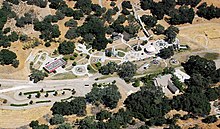
An aerial view of part of Jackson’s 2,800-acre (11 km2) Neverland Valley Ranch near Los Olivos, California, showing the many rides.
In late 2008, Fortress Investments threatened to foreclose on Neverland Ranch, which Jackson used as collateral for loans running into many tens of millions of dollars. However, Fortress opted to sell Jackson’s debts to Colony Capital LLC. In November, Jackson transferred Neverland Ranch’s title to Sycamore Valley Ranch Company LLC, a joint venture between Jackson and Colony Capital LLC. The deal cleared Jackson’s debt and reportedly earned him an additional $35 million. At the time of his death, Jackson still owned a stake of unknown size in Neverland/Sycamore Valley.[272][273] In September 2008, Jackson entered negotiations with Julien’s Auction House to display and auction a large collection of memorabilia amounting to approximately 1,390 lots. The auction was scheduled to take place between April 22 and 25.[274] An exhibition of the lots opened as scheduled on April 14, but the actual auction was eventually cancelled at Jackson’s request.[275]
In March 2009, Jackson held a press conference at London’s O2 Arena to announce a series of comeback concerts titled This Is It. The shows would be Jackson’s first major series of concerts since the HIStory World Tour finished in 1997. Jackson suggested possible retirement after the shows, saying it would be his “final curtain call”. The initial plan was for 10 concerts in London, followed by shows in Paris, New York City and Mumbai. Randy Phillips, president and chief executive of AEG Live, stated that the first 10 dates alone would earn the singer approximately £50 million.[276] The London residency was increased to 50 dates after record-breaking ticket sales: over one million were sold in less than two hours.[277] The concerts would have commenced on July 13, 2009, and finished on March 6, 2010. Jackson rehearsed in Los Angeles in the weeks leading up to the tour under the direction of choreographer Kenny Ortega. Most of these rehearsals took place at the Staples Center, owned by AEG.[278] Less than three weeks before the first show was due to begin in London, with all concerts sold out, Jackson died after suffering cardiac arrest.[279] Some time before his death, it was reported that he was starting a clothing line with Christian Audigier.[280][281]
Jackson’s first posthumous song released entirely by his estate was “This Is It“, which he had co-written in the 1980s with Paul Anka. It was not on the setlists for the concerts, and the recording was based on an old demo tape. The surviving brothers reunited in the studio for the first time since 1989 to record backing vocals. On October 28, 2009, a documentary film about the rehearsals, Michael Jackson’s This Is It, was released.[282] Despite a limited two-week engagement, it became the highest-grossing documentary or concert film of all time, with earnings of more than $260 million worldwide.[283] Jackson’s estate received 90% of the profits.[284] The film was accompanied by a compilation album of the same name. Two versions of “This Is It” appear on the album, which also featured original masters of Jackson’s hits in the order in which they appear in the film, along with a bonus disc with previously unreleased versions of more Jackson hits and a spoken-word poem, “Planet Earth”.[285] At the 2009 American Music Awards, Jackson won four posthumous awards, two for him and two for his album Number Ones, bringing his total American Music Awards to 26.[286][287]
Death and memorial
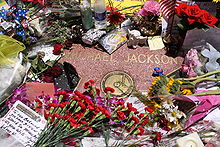
Fans flocked to Jackson’s star on the Hollywood Walk of Fame, adorning it with flowers and notes on the day of his death.
On June 25, 2009, Jackson fell unconscious while lying in bed at his rented mansion at 100 North Carolwood Drive in the Holmby Hillsdistrict of Los Angeles. Attempts at resuscitating him by Conrad Murray, his personal physician, were unsuccessful.[288] Los Angeles Fire Department paramedics received a 911 call at 12:22 pm (PDT, 19:22 UTC), arriving three minutes later.[289][290] Jackson was reportedly not breathing and CPR was performed.[291] Resuscitation efforts continued en route to Ronald Reagan UCLA Medical Center, and for more than an hour after arriving there at 1:13 pm (20:13 UTC). He was pronounced dead at 2:26 pm Pacific time (21:26 UTC).[292][293]
Jackson’s death triggered a global outpouring of grief.[288] The news spread quickly online, causing websites to slow down and crashfrom user overload. Both TMZ and the Los Angeles Times suffered outages.[294] Google initially believed that the millions of search requests meant their search engine was under DDoS attack, and blocked searches related to Michael Jackson for 30 minutes. Twitter reported a crash, as did Wikipedia at 3:15 pm PDT (22:15 UTC).[295] The Wikimedia Foundation reported nearly a million visitors to Jackson’s biography within one hour, probably the most visitors in a one-hour period to any article in Wikipedia’s history.[296] AOL Instant Messenger collapsed for 40 minutes. AOL called it a “seminal moment in internet history … We’ve never seen anything like it in terms of scope or depth.”[297] Around 15% of Twitter posts (5,000 tweets per minute) reportedly mentioned Jackson after the news broke,[298][299]compared to the 5% recalled as having mentioned the Iranian elections or the flu pandemic that had made headlines earlier in the year.[299] Overall, web traffic ranged from 11% to at least 20% higher than normal.[298][300] MTV and BET aired marathons of Jackson’s music videos.[301] Jackson specials aired on television stations around the world. The British soap opera EastEnders added a last-minute scene to the June 26 episode in which one character tells another about the news.[302] MTV briefly returned to its original music video format to celebrate his work,[303] airing hours of Jackson’s music videos, accompanied by live news specials featuring reactions from MTV personalities and other celebrities.[304] The temporary shift in MTV’s programming culminated the following week in the channel’s live coverage of Jackson’s memorial service.[304]

Jackson’s tomb in the Holly Terrace of the Great Mausoleum, Forest Lawn Glendale.
Jackson’s memorial was held on July 7, 2009 at the Staples Center in Los Angeles, preceded by a private family service at Forest Lawn Memorial Park’s Hall of Liberty. Due to high demand, tickets to the memorial were distributed via lottery, and over 1.6 million fans applied for tickets during the two-day application period. 8,750 names were drawn at random, with each recipient receiving two tickets each.[305]Jackson’s casket was present during the memorial but no information was released about the final disposition of the body. The memorial service was one of the most watched events in streaming history,[306] with an estimated U.S. audience of 31.1 million, an amount comparable to the estimated 35.1 million that watched the 2004 burial of former president Ronald Reagan, and the estimated 33.1 millionAmericans who watched the 1997 funeral for Princess Diana.[307]
Mariah Carey, Stevie Wonder, Lionel Richie, John Mayer, Jennifer Hudson, Usher, Jermaine Jackson, and Shaheen Jafargholiperformed at the event. Berry Gordy and Smokey Robinson gave eulogies, while Queen Latifah read “We Had Him”, a poem written for the occasion by Maya Angelou.[308] The Reverend Al Sharpton received a standing ovation with cheers when he told Jackson’s children: “Wasn’t nothing strange about your daddy. It was strange what your daddy had to deal with. But he dealt with it anyway.”[309] Jackson’s 11-year-old daughter Paris Katherine, speaking publicly for the first time, wept as she told the crowd: “Ever since I was born, Daddy has been the best father you could ever imagine … I just wanted to say I love him … so much.”[310][311] Reverend Lucious Smith provided a closing prayer.[312]
At the time of death, Jackson had been administered propofol, lorazepam, and midazolam,[313] and the Los Angeles coroner decided to treat the death as a homicide.[314][315] Law enforcement officials conducted a manslaughter investigation of his personal physician Conrad Murray, and charged him with involuntary manslaughter in Los Angeles on February 8, 2010.[316] Jackson’s body was entombed on September 3, 2009, at Forest Lawn Memorial Park in Glendale, California.[317]
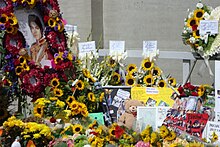
Tribute of fans from all over the world in the Forest Lawn Memorial Park on the first anniversary of his death.
On June 25, 2010, the first anniversary of Jackson’s death, fans traveled to Los Angeles to pay tribute. They visited Jackson’s star on the Hollywood Walk of Fame, his family’s home, and Forest Lawn Memorial Park. Many of the fans were carrying sunflowers and other tribute items to leave at the sites. Members of the Jackson family and close friends arrived to pay their respects.[318][319] Katherine returned to Gary, Indiana to unveil a granite monument constructed in the front yard of the family home. The memorial continued with a candlelight vigil and a special performance of “We Are the World”.[320][321] On June 26, there was a protest march in front of the Los Angeles Police Department’s Robbery-Homicide Division at the old Parker Center building and a petition with thousands of signatures demanding justice.[322][323] The Jackson Family Foundation, in conjunction with Voiceplate, presented “Forever Michael”, an event bringing together Jackson family members, celebrities, fans, supporters and the community to celebrate and honor his legacy. A portion of the proceeds were presented to some of Jackson’s favorite charities. Katherine also introduced her new book “Never Can Say Goodbye”.[324][325][326]
Aftermath
In the 12 months after his death, Jackson sold more than 8.2 million albums in the United States and 35 million albums worldwide, making him the best-selling albums artist of 2009.[327][328] He became the first artist to sell one million downloads in a week in music download history, with a record-breaking 2.6 million downloads of his songs. Three of his albums sold more than any new album, the first time a catalog album has ever scanned more sales than any new album.[329] Jackson also became the first artist in history to have four of the top 20 best-selling albums in a single year in the United States.[327] Following this surge in sales, Sony announced that they had extended their distribution rights for Jackson’s material, which had been due to expire in 2015.[330] On March 16, 2010, Sony Music Entertainment, spearheaded by its Columbia/Epic Label Group division, signed a new deal with the Jackson estate to extend their distribution rights to his back catalogue until at least 2017, and release ten new albums of previously unreleased material and new collections of released work.[331]
On November 4, 2010, Sony announced the first posthumous album, Michael, released on December 14, with the promotional single, “Breaking News“, released to radio on November 8.[332] Sony Music reportedly paid the Jackson estate $250 million for the deal, plus royalties, making it the most expensive music contract pertaining to a single artist in history.[330][333] Video game developer Ubisoft announced a dancing-and-singing game featuring Michael Jackson for the 2010 holiday season, Michael Jackson: The Experience; it is among the first games to use Kinect and PlayStation Move, the motion-detecting camera systems for Microsoft’s Xbox 360 and Sony’s PlayStation 3respectively.[334]
On November 3, 2010, the theatrical performing company Cirque du Soleil announced that it would launch Michael Jackson: The Immortal World Tour in October 2011 in Montreal, while a permanent show will reside in Las Vegas.[335] The 90-minute $57-million production will combine Jackson’s music and choreography with the Cirque’s artistry, dance and aerial displays involving 65 artists.[336] The tour was written and directed by Jamie King[337] and centers on Jackson’s “inspirational Giving Tree – the wellspring of creativity where his love of music and dance, fairy tale and magic, and the fragile beauty of nature are unlocked.”[338] On October 3, 2011, the accompanying compilation soundtrack album Immortal was announced to have over 40 Jackson’s original recordings re-produced by Kevin Antunes.[339] A second, larger and more theatrical Cirque show,Michael Jackson: One, designed for residency at the Mandalay Bay resort in Las Vegas, was announced on February 21, 2013. This show, also produced, written and directed by King, began its run on May 23, 2013 in a newly renovated theater to critical and commercial success.[340][341][342][343]
In April 2011, billionaire businessman Mohamed Al-Fayed, chairman of Fulham Football Club and Jackson’s longtime friend, unveiled a statue of Michael Jackson outside the club’s stadium, Craven Cottage.[344] Fulham fans were bemused by the statue and failed to understand the relevance of Jackson to the club.[345] Al Fayed defended the statue and told the fans to “go to hell” if they did not appreciate it.[344] The statue was removed in September 2013[346] and moved to the National Football Museum in Manchester in May 2014.[347]
In 2012, in an attempt to end public family feuding, Jackson’s brother Jermaine Jackson retracted his signature on a public letter criticizing executors of Michael Jackson’s estate and his mother’s advisers concerning the legitimacy of his brother’s will.[348] T.J. Jackson, son of Tito Jackson, was given co-guardianship of Michael Jackson’s children after false reports surfaced of Katherine Jackson going missing.[349]
On May 16, 2013, choreographer Wade Robson alleged on The Today Show that Jackson “performed sexual acts on me and forced me to perform sexual acts on him” for 7 years, beginning when Robson was 7 years old.[350] Robson had previously testified in defence of Jackson at the singer’s 2005 child molestation trial.[351] The attorney for Jackson’s estate described Robson’s claim as “outrageous and pathetic”.[352] The date for the hearing which will determine whether Robson can sue Jackson’s estate was scheduled for June 2, 2014.[353] In February 2014, the Internal Revenue Service reported that Jackson’s estate owed $702 million, including $505 million in taxes and $197 million in penalties after they claimed the estate undervalued Jackson’s fortune.[354]
On March 31, 2014, Epic Records announced Xscape, an album of eight songs of unreleased material culled from past recording sessions.[355] It was released on May 13, 2014.[356] On May 12, 2014, another young man, Jimmy Safechuck, sued Jackson’s estate, claiming Jackson sexually abused him “from the age of 10 to about 14 or 15” in the 1980s.[357] During the 2014 Billboard Music Awards on May 18, a “Pepper’s ghost” likeness of Jackson appeared, dancing to “Slave to the Rhythm“, one of the tracks fromXscape.[358] Later that year, Queen released three duets that Freddie Mercury had recorded with Jackson in the 1980s.[72]
Jackson’s earnings have exponentially increased following his sudden death in comparison to his final years alive. According to Forbes, he has been the top-earning dead celebrity each year since his death, with triple-digit millions per annum ($115 million in 2015).[22] In December 2015, Jackson’s album Thriller became the first album in the United States to surpass 30 million shipments, certifying it 30× platinum by the RIAA.[82] Two months later, Billboard reported that the album was certified again at 32× platinum, surpassing 32 million shipments after Soundscan added streams and audio downloads to album certifications.[359]
Artistry
Influences

One of many identical statues, based on Diana Walczak‘s original HIStory statue, positioned throughout Europe to promote HIStory.
Jackson was influenced by musicians including Little Richard, James Brown,[360] Jackie Wilson, Diana Ross, Fred Astaire,[360] Sammy Davis Jr.,[360] Gene Kelly,[360][361] David Ruffin,[362] the Isley Brothers, and the Bee Gees.[363] According to choreographer David Winters, who met and befriended Jackson while choreographing the 1971 Diana Ross TV special Diana!, Jackson watched the musical West Side Story almost every week, and it was his favorite film; he paid tribute to it in “Beat It” and the “Bad” video.[363][364][365] While Little Richard had a substantial influence on Jackson,[366] James Brown was Jackson’s greatest inspiration. In reference to Brown, Jackson declared: “Ever since I was a small child, no more than like six years old, my mother would wake me no matter what time it was, if I was sleeping, no matter what I was doing, to watch the television to see the master at work. And when I saw him move, I was mesmerized. I had never seen a performer perform like James Brown, and right then and there I knew that was exactly what I wanted to do for the rest of my life because of James Brown.”[367]
The young Jackson owed his vocal technique in large part to Diana Ross. Not only a mother figure to him, she was often observed in rehearsal as an accomplished performer.[clarification needed] He later said: “I got to know her well. She taught me so much. I used to just sit in the corner and watch the way she moved. She was art in motion. I studied the way she moved, the way she sang – just the way she was.” He told her: “I want to be just like you, Diana.” She said: “You just be yourself.”[368] Jackson owed part of his enduring style—especially his use of the oooh interjection—to Ross. From a young age, Jackson often punctuated his verses with a sudden exclamation of oooh. Diana Ross had used this effect on many of the songs recorded with the Supremes.[369]
Musical themes and genres
Jackson explored a variety of music genres, including pop, soul, rhythm and blues, funk, rock, disco, post-disco, dance-pop and new jack swing.[4][155][370][371][372][373] Unlike many artists, Jackson did not write his songs on paper and instead dictated into a sound recorder.[374] When composing music, he preferred to beatbox and imitate instruments vocally rather than use instruments.[375]
According to Steve Huey of AllMusic,[4] Thriller refined the strengths of Off the Wall; the dance and rock tracks were more aggressive, while the pop tunes and ballads were softer and more soulful.[4] Its tracks included the ballads “The Lady in My Life”, “Human Nature“, and “The Girl Is Mine“, the funk pieces “Billie Jean” and “Wanna Be Startin’ Somethin’“, and the disco set “Baby Be Mine” and “P.Y.T. (Pretty Young Thing)“.[4][376][377][378] With Thriller, Christopher Connelly of Rolling Stone commented that Jackson developed his long association with the subliminal theme of paranoia and darker imagery.[378] AllMusic’sStephen Thomas Erlewine noted this is evident on the songs “Billie Jean” and “Wanna Be Startin’ Somethin'”.[376] In “Billie Jean”, Jackson sings about an obsessive fan who alleges he has fathered a child of hers.[4] In “Wanna Be Startin’ Somethin'” he argues against gossip and the media.[378] “Beat It” decried gang violence in an homage to West Side Story, and was Jackson’s first successful rock cross-over piece, according to Huey.[4][48] He also observed that the title track “Thriller” began Jackson’s interest with the theme of the supernatural, a topic he revisited in subsequent years.[4] In 1985, Jackson co-wrote the charity anthem “We Are the World“; humanitarian themes later became a recurring theme in his lyrics and public persona.[4]
|
|
Jackson’s song “Thriller”, released as a single in 1984, utilizes cinematic sound effects, horror film motifs, and vocal trickery to convey a sense of danger. [59]
A single from the album Bad, released 1988, “Smooth Criminal” features digital drum sounds, keyboard-created bass lines, and other percussion elements designed to give the impression of a pulsing heart. [379]
The lead single from Dangerous, “Black or White” is a danceable rock song with hard rock elements. It was one of Jackson’s most successful recordings. [380][381]
|
| Problems playing these files? See media help. |
In Bad, Jackson’s concept of the predatory lover can be seen on the rock song “Dirty Diana“.[382] The lead single “I Just Can’t Stop Loving You” is a traditional love ballad, while “Man in the Mirror” is an anthemic ballad of confession and resolution. “Smooth Criminal” was an evocation of bloody assault, rape and likely murder.[135] AllMusic’s Stephen Thomas Erlewinestates that Dangerous presents Jackson as a very paradoxical individual.[383] He comments the album is more diverse than his previous Bad, as it appeals to an urban audience while also attracting the middle class with anthems like “Heal the World“.[383] The first half of the record is dedicated to new jack swing, including songs like “Jam” and “Remember the Time“.[384] The album is Jackson’s first where social ills become a primary theme; “Why You Wanna Trip on Me”, for example, protests against world hunger, AIDS, homelessness and drugs.[384] Dangerous contains sexually charged efforts such as the multifaceted love song, “In the Closet“.[384] The title track continues the theme of the predatory lover and compulsive desire.[384] The second half includes introspective, pop-gospel anthems such as “Will You Be There“, “Heal the World” and “Keep the Faith”; these songs show Jackson opening up about various personal struggles and worries.[384] In the ballad “Gone Too Soon“, Jackson gives tribute to his friend Ryan White and the plight of those with AIDS.[385]
HIStory creates an atmosphere of paranoia.[386] Its content focuses on the hardships and public struggles Jackson went through just prior to its production. In the new jack swing-funk-rock efforts “Scream” and “Tabloid Junkie”, along with the R&B ballad “You Are Not Alone“, Jackson retaliates against the injustice and isolation he feels, and directs much of his anger at the media.[387] In the introspective ballad “Stranger in Moscow“, Jackson laments over his “fall from grace”, while songs like “Earth Song“, “Childhood“, “Little Susie” and “Smile” are all operatic pop pieces.[386][387] In the track “D.S.“, Jackson launched a verbal attack against Tom Sneddon. He describes Sneddon as an antisocial, white supremacist who wanted to “get my ass, dead or alive”. Of the song, Sneddon said, “I have not—shall we say—done him the honor of listening to it, but I’ve been told that it ends with the sound of a gunshot”.[388]Invincible found Jackson working heavily with producer Rodney Jerkins.[4] It is a record made up of urban soul like “Cry” and “The Lost Children”, ballads such as “Speechless“, “Break of Dawn”, and “Butterflies” and mixes hip hop, pop, and R&B in “2000 Watts”, “Heartbreaker” and “Invincible”.[389][390]
Vocal style
Jackson sang from childhood, and over time his voice and vocal style changed noticeably. Between 1971 and 1975, Jackson’s voice descended from boy soprano to high tenor.[391] His vocal range as an adult was F2-E♭6. Jackson first used a technique called the “vocal hiccup” in 1973, starting with the song “It’s Too Late to Change the Time” from the Jackson 5‘s G.I.T.: Get It Together album.[392] Jackson did not use the hiccup technique—somewhat like a gulping for air or gasping—fully until the recording of Off the Wall: it can be seen in full force in the “Shake Your Body (Down to the Ground)” promotional video.[54] With the arrival of Off the Wall in the late 1970s, Jackson’s abilities as a vocalist were well regarded. At the time, Rolling Stone compared his vocals to the “breathless, dreamy stutter” of Stevie Wonder. Their analysis was also that “Jackson’s feathery-timbred tenor is extraordinarily beautiful. It slides smoothly into a startling falsetto that’s used very daringly”.[370][393] 1982 saw the release of Thriller, and Rolling Stonewas of the opinion that Jackson was then singing in a “fully adult voice” that was “tinged by sadness”.[378]
A distinctive deliberate mispronunciation of “come on”, used frequently by Jackson, occasionally spelled “c’mon”, “cha’mone”, or “shamone”, is also a staple in impressions and caricatures of him.[394] The turn of the 1990s saw the release of the introspective album Dangerous. The New York Times noted that on some tracks, “he gulps for breath, his voice quivers with anxiety or drops to a desperate whisper, hissing through clenched teeth” and he had a “wretched tone”.[384] When singing of brotherhood or self-esteem the musician would return to “smooth” vocals.[384] When commenting on Invincible, Rolling Stone were of the opinion that—at the age of 43—Jackson still performed “exquisitely voiced rhythm tracks and vibrating vocal harmonies”.[395] Nelson George wrote: “The grace, the aggression, the growling, the natural boyishness, the falsetto, the smoothness—that combination of elements mark him as a major vocalist”.[379] Cultural critic Joseph Vogel notes that Jackson had a “distinctive styles is his ability to convey emotion without the use of language: there are his trademark gulps, grunts, gasps, cries, exclamations; he also frequently scats or twists and contorts words until they are barely discernible.”[396]Neil McCormick notes that Jackson’s unorthodox singing style “was original and utterly distinctive, from his almost ethereal falsetto to his soft, sweet mid-tones; his fluid, seamless control of often very fast moving series of notes; his percussive yet still melodic outbursts, ululations and interjections (from those spooky “tee-hee-hees” to grunts and wails). Unusually for someone coming from a black American soul tradition, he did not often sing straight, unadorned ballads, though when he did (from ‘Ben‘ to ‘She’s Out of My Life‘) the effect was of a powerful simplicity and truth.”[397]
Music videos and choreography
Jackson has been called the King of Music Videos.[398] Steve Huey of AllMusic observed how Jackson transformed the music video into an art form and a promotional tool through complex story lines, dance routines, special effects and famous cameo appearances, simultaneously breaking down racial barriers.[4] Before Thriller, Jackson struggled to receive coverage on MTV, allegedly because he was African American.[399] Pressure from CBS Records persuaded MTV to start showing “Billie Jean” and later “Beat It”, leading to a lengthy partnership with Jackson, also helping other black music artists gain recognition.[400] MTV employees deny any racism in their coverage, or pressure to change their stance. MTV maintains that they played rock music, regardless of race.[401] The popularity of his videos on MTV helped to put the relatively young channel “on the map”; MTV’s focus shifted in favor of pop and R&B.[400][402] His performance on Motown 25: Yesterday, Today, Forever changed the scope of live stage show; “That Jackson lip-synced ‘Billie Jean’ is, in itself, not extraordinary, but the fact that it did not change the impact of the performance is extraordinary; whether the performance was live or lip-synced made no difference to the audience” thus creating an era in which artists re-create the spectacle of music video imagery on stage.[403] Short films like Thriller largely remained unique to Jackson, while the group dance sequence in “Beat It” has frequently been imitated.[404] The choreography in Thriller has become a part of global pop culture, replicated everywhere from Indian films to prisons in the Philippines.[405] The Thriller short film marked an increase in scale for music videos, and has been named the most successful music video ever by the Guinness World Records.[158]
In the 19-minute music video for “Bad“—directed by Martin Scorsese—Jackson began using sexual imagery and choreography not previously seen in his work. He occasionally grabbed or touched his chest, torso and crotch. When asked by Oprah in the 1993 interview about why he grabbed his crotch, he replied, “I think it happens subliminally” and he described it as something that was not planned, but rather, as something that was compelled by the music. “Bad” garnered a mixed reception from both fans and critics; Timemagazine described it as “infamous”. The video also featured Wesley Snipes; in the future Jackson’s videos would often feature famous cameo roles.[127][406] For the “Smooth Criminal” video, Jackson experimented with an anti-gravity lean where the performer leans forward at a 45 degree angle, beyond the performer’s center of gravity. To accomplish this move live, Jackson and designers developed a special shoe that locks the performer’s feet to the stage, allowing them to lean forward. They were granted U.S. Patent 5,255,452 for the device.[407] Although the music video for “Leave Me Alone” was not officially released in the US, in 1989 it was nominated for three Billboard Music Video Awards;[408] the same year it won a Golden Lion Award for the quality of the special effects used in its production. In 1990, “Leave Me Alone” won a Grammy for Best Music Video, Short Form.[153]
He received the MTV Video Vanguard Award in 1988 and the MTV Video Vanguard Artist of the Decade Award in 1990 to celebrate his accomplishments in the art form in the 1980s; in 1991 the first award was renamed in his honor.[169] “Black or White” was accompanied by a controversial music video, which, on November 14, 1991, simultaneously premiered in 27 countries with an estimated audience of 500 million people, the largest viewing ever for a music video at that time.[168] It featured scenes construed as having a sexual nature as well as depictions of violence. The offending scenes in the final half of the 14-minute version were edited out to prevent the video from being banned, and Jackson apologized.[409] Along with Jackson, it featured Macaulay Culkin, Peggy Lipton, and George Wendt. It helped usher in morphing as an important technology in music videos.[410]
“Remember the Time” was an elaborate production, and became one of his longest videos at over nine minutes. Set in ancient Egypt, it featured groundbreaking visual effectsand appearances by Eddie Murphy, Iman, and Magic Johnson, along with a distinct complex dance routine.[411] The video for “In the Closet” was Jackson’s most sexually provocative piece. It featured supermodel Naomi Campbell in a courtship dance with Jackson. The video was banned in South Africa because of its imagery.[169]
The music video for “Scream“, directed by Mark Romanek and production designer Tom Foden, is one of Jackson’s most critically acclaimed. In 1995, it gained eleven MTV Video Music Award Nominations—more than any other music video—and won “Best Dance Video”, “Best Choreography”, and “Best Art Direction”.[412] The song and its accompanying video are a response to the backlash Jackson received from the media after being accused of child molestation in 1993.[413] A year later, it won a Grammy for Best Music Video, Short Form; shortly afterwards Guinness World Records listed it as the most expensive music video ever made, at a cost of $7 million.[222][414]
“Earth Song” was accompanied by an expensive and well-received music video, which gained a Grammy nomination for Best Music Video, Short Form in 1997. The video had an environmental theme, showing images of animal cruelty, deforestation, pollution and war. Using special effects, time is reversed so that life returns, wars end, and the forests re-grow.[222][415] Released in 1997 and premiering at the 1996 Cannes Film Festival, Michael Jackson’s Ghosts was a short film written by Jackson and Stephen King and directed by Stan Winston. The video for Ghosts is over 38 minutes long and holds the Guinness World Record as the world’s longest music video.[222][231][416][417]
The music video for “You Rock My World“, which is thirteen and a half minutes long, was directed by Paul Hunter, and was released in 2001. The video features appearances from Chris Tucker and Marlon Brando.[418] The video won an NAACP Image Award for Outstanding Music Video at the award shows 2002 ceremony.[419]
Legacy and influence
The media has commonly referred to Jackson as the “King of Pop” because, throughout his career, he transformed the art of music videos and paved the way for modern pop music. For much of Jackson’s career, he had an unparalleled worldwide influence over the younger generation through his musical and humanitarian contributions.[224] His music and videos, such as Thriller, fostered racial diversity in MTV’s roster and steered its focus from rock to pop music and R&B, shaping the channel into a form that proved enduring. Jackson’s work continues to influence numerous artists of various music genres.
Danyel Smith, the chief content officer of Vibe Media Group and the editor-in-chief of Vibe describes Jackson as “The Greatest Star”.[420]AllMusic‘s Steve Huey describes Jackson as “an unstoppable juggernaut, possessed of all the skills to dominate the charts seemingly at will: an instantly identifiable voice, eye-popping dance moves, stunning musical versatility and loads of sheer star power”.[4] BET described Jackson “as quite simply the greatest entertainer of all time” and someone who “revolutionized the music video and brought dances like the moonwalk to the world. Jackson’s sound, style, movement and legacy continues to inspire artists of all genres.”[421]
In 1984, Time magazine’s pop critic Jay Cocks wrote that “Jackson is the biggest thing since the Beatles. He is the hottest single phenomenon since Elvis Presley. He just may be the most popular black singer ever.”[89] In 1990, Vanity Fair cited Jackson as the most popular artist in the history of show business.[153] In 2003, Daily Telegraph writer Tom Utley described Jackson as “extremely important” and a “genius”.[422] In 2007, Jackson said: “Music has been my outlet, my gift to all of the lovers in this world. Through it, my music, I know I will live forever.”[423]
At Jackson’s memorial service on July 7, 2009, Motown founder Berry Gordy proclaimed Jackson “the greatest entertainer that ever lived”.[424][425][426] In a June 28, 2009Baltimore Sun article titled “7 Ways Michael Jackson Changed The World”, Jill Rosen wrote that Jackson’s legacy was “as enduring as it is multi-faceted”, influencing fields including sound, dance, fashion, music videos and celebrity.[427] On December 19, 2014, the British Council of Cultural Relations named Jackson’s life one of the 80 most important cultural moments of the 20th century.[428]
In July 2009, the Lunar Republic Society, which promotes the exploration, settlement and development of the Moon, named a Moon crater after Jackson.[429] In the same year, for Jackson’s 51st birthday, Google dedicated their Google Doodle to him.[430] In 2010, two university librarians found that Jackson’s influence extended to academia, with references to Jackson in reports concerning music, popular culture, chemistry and an array of other topics.[431][432][433]
Honors and awards

Thriller platinum record on display at the Hard Rock Cafe, Hollywood in Universal City, California.
Michael Jackson was inducted onto the Hollywood Walk of Fame in 1980 as member of the Jacksons and in 1984 as solo artist. Throughout his career he received numerous honors and awards, including the World Music Awards‘ Best-Selling Pop Male Artist of the Millennium, theAmerican Music Award‘s Artist of the Century Award and the Bambi Pop Artist of the Millennium Award.[238][434] He was a double-inductee of theRock and Roll Hall of Fame, once as a member of The Jackson 5 in 1997 and later as a solo artist in 2001. Jackson was also inducted in several other halls of fame, including Vocal Group Hall of Fame (as a Jackson 5 member) in 1999 and the Songwriters Hall of Fame in 2002.[238] In 2010, Jackson was inducted into the Dance Hall of Fame as the first (and currently only) dancer from the world of pop and rock ‘n’ roll.[435] In 2014, Jackson was inducted into the second class of inductees to the Rhythm and Blues Music Hall of Fame; his father Joe Jackson accepted on his behalf.[436]
His awards include many Guinness World Records (eight in 2006 alone), including for the Most Successful Entertainer of All Time,[15][16] 13Grammy Awards[437] (as well as the Grammy Legend Award[438] and the Grammy Lifetime Achievement Award),[439] 26 American Music Awards(including the “Artist of the Century” and “Artist of the 1980s”),[235][440]—more than any artist—13 number-one singles in the US in his solo career—more than any other male artist in the Hot 100 era[441]—and estimated sales of over 350 million records worldwide[442][Note 1] making him one of the best-selling artists in modern music history.[443] On December 29, 2009, the American Film Institute recognized Jackson’s death as a “moment of significance” saying, “Michael Jackson’s sudden death in June at age 50 was notable for the worldwide outpouring of grief and the unprecedented global eulogy of his posthumous concert rehearsal movie This Is It.”[444] Michael Jackson also received an Honorary Doctor of Humane Letters Degree from the United Negro College Fund[445] and also an Honorary Doctorate of Humane Letters from Fisk University.[446]
Earnings and wealth
It is estimated that Michael Jackson earned about $750 million in his lifetime.[447] Sales of his recordings through Sony’s music unit earned him an estimated $300 million in royalties. He may have also earned an additional $400 million from concerts, music publishing (including his share of the Beatles catalog), endorsements, merchandising and music videos. Estimating how much of these earnings Jackson was able to personally pocket is difficult because one has to account for taxes, recording costs and production costs.[448]
Net worth during Jackson’s life
There have also been several detailed estimates of Jackson’s net worth during his life, which range from negative $285 million to positive $350 million for the years 2002, 2003 and 2007.
Michael Jackson’s estimated net-worth over the years
| Year |
Assets |
Debt |
Net worth |
Source |
| 2002 |
$130 million |
$415 million |
-$285 million |
Forensic accountant in 2005 recalling Jackson’s 2002 balance sheet under oath[449] |
| 2003 |
$550 million ($100 million in properties including Neverland ranch; Encino and Las Vegas homes and other properties and $450 million in music holdings including 50% stake in Sony ATV and other music publishing) |
$200 million |
$350 million |
Forbes, November 21, 2003[450] |
| 2007 |
$567.6 million (includes 50% share of the Sony/ATV catalog valued at $390.6 million, Neverland valued at $33 million, cars, antiques, collectibles and other property valued at $20 million, and $668,215 in cash) |
$331 million |
$236 million |
Michael Jackson’s March 2007 statement of financial condition prepared by Washington-based accounting firm Thompson, Cobb, Bazilio & Associates; described by CBS News as the clearest account yet of Jackson’s finances.[451] |
Net worth at time of death; U.S. federal estate tax problems
On July 26, 2013, the executors of the Estate of Michael Jackson filed a petition in the United States Tax Court as a result of a dispute with the Internal Revenue Service (IRS) over U.S. federal estate taxes imposed on the value of Jackson’s Estate at the time of his death.[452] The executors of the Estate claim that the Estate was worth about $7 million. The IRS asserts that the Estate was worth over $1.1 billion, and that over $700 million in federal estate taxes (including penalties) are due.[354] A trial date of February 6, 2017 has been set.[453]
In 2016, Forbes magazine estimated annual gross earnings by the Jackson Estate at $825 million, the largest ever recorded for a celebrity. The majority was due to the sale of the Sony/ATV catalog. It marked the eighth consecutive year since his death where Jackson’s annual earnings were over $100 million.[22]
Michael Jackson
From Wikipedia, the free encyclopedia
| Michael Jackson |

|
| Born |
Michael Joseph Jackson
August 29, 1958
Gary, Indiana, U.S. |
| Died |
June 25, 2009 (aged 50)
Los Angeles, California, U.S. |
| Cause of death |
Homicide[1] (Involuntary manslaughter)[2] |
| Resting place |
Glendale, California, U.S. |
| Residence |
Los Olivos, California, U.S. |
| Occupation |
- Singer
- songwriter
- dancer
- actor
- record producer
- businessman
- philanthropist
|
| Net worth |
US $236 Million (2007 estimate) |
| Spouse(s) |
Lisa Marie Presley
(m. 1994; div. 1996)
Debbie Rowe
(m. 1996; div. 1999) |
| Children |
3 |
| Parent(s) |
|
| Relatives |
See Jackson family |
| Website |
michaeljackson.com |
| Musical career |
| Genres |
|
| Instruments |
Vocals |
| Years active |
1964–2009 |
| Labels |
|
| Associated acts |
The Jackson 5 |
| Signature |
 |
Michael Joseph Jackson[3][4] (August 29, 1958 – June 25, 2009) was an American singer and philanthropist.[5][6][7] Called the “King of Pop“,[8][9][10][11] his contributions to music, dance, and fashion[12][13][14] along with his publicized personal life made him a global figure in popular culture for over four decades.
The eighth child of the Jackson family (one of whom died in infancy), Michael made his professional debut in 1964 with his elder brothers Jackie, Tito, Jermaine, and Marlon as a member of the Jackson 5. He began his solo career in 1971. In the early 1980s, Jackson became a dominant figure in popular music. His music videos, including those of “Beat It“, “Billie Jean“, and “Thriller” from his 1982 album Thriller, are credited with breaking racial barriers and transforming the medium into an art form and promotional tool. The popularity of these videos helped bring the television channel MTV to fame. Jackson’s 1987 album Bad spawned the U.S.Billboard Hot 100 number-one singles “I Just Can’t Stop Loving You“, “Bad“, “The Way You Make Me Feel“, “Man in the Mirror“, and “Dirty Diana“, becoming the first album to have five number-one singles on the Billboard Hot 100. He continued to innovate with videos such as “Black or White” and “Scream” throughout the 1990s, and forged a reputation as a touring solo artist. Through stage and video performances, Jackson popularized a number of complicated dance techniques, such as the robot and the moonwalk, to which he gave the name. His distinctive sound and style has influenced numerous artists of various music genres.
Thriller is the best-selling album of all time, with estimated sales of 65 million copies worldwide. Jackson’s other albums, includingOff the Wall (1979), Bad (1987), Dangerous (1991), and HIStory (1995), also rank among the world’s best-selling albums. He is recognized as the Most Successful Entertainer of All Time by Guinness World Records.[15][16] Jackson is one of the few artists to have been inducted into the Rock and Roll Hall of Fame twice, and was also inducted into the Songwriters Hall of Fame and the Dance Hall of Fame as the only dancer from pop and rock music. His other achievements include multiple Guinness World Records, 13 Grammy Awards, the Grammy Legend Award, the Grammy Lifetime Achievement Award, 26 American Music Awards—more than any other artist—including the “Artist of the Century” and “Artist of the 1980s”, 13 number-one singles in the United Statesduring his solo career,—more than any other male artist in the Hot 100 era—and estimated sales of over 350 million records worldwide.[Note 1] Jackson has won hundreds of awards, making him the most awarded recording artist in the history of popular music.[17] He became the first artist in history to have a top ten single in the Billboard Hot 100 in five different decades when “Love Never Felt So Good” reached number nine on May 21, 2014.[18] Jackson traveled the world attending events honoring his humanitarianism, and, in 2000, the Guinness World Records recognized him for supporting 39 charities, more than any other entertainer.[19]
Aspects of Jackson’s personal life, including his changing appearance, personal relationships, and behavior, generated controversy. In 1993, he was accused of child sexual abuse, but the civil case was settled out of court for an undisclosed amount and no formal charges were brought.[20] In 2005, he was tried and acquitted of further child sexual abuse allegations and several other charges after the jury found him not guilty on all counts. While preparing for his comeback concert series, This Is It, Jackson died of acutepropofol and benzodiazepine intoxication on June 25, 2009, after suffering from cardiac arrest. The Los Angeles County Coronerruled his death a homicide, and his personal physician, Conrad Murray, was convicted of involuntary manslaughter. Jackson’s death triggered a global outpouring of grief, and a live broadcast of his public memorial service was viewed around the world.[21] Forbesranks Jackson as the top-earning dead celebrity, with yearly earnings of $825 million in 2016, the highest ever recorded by the publication.[22]
- 1Life and career
- 1.11958–1975: Early life and the Jackson 5
- 1.21975–1981: Move to Epic and Off the Wall
- 1.31982–1983: Thriller and Motown 25: Yesterday, Today, Forever
- 1.41984–1985: Pepsi, “We Are the World”, and business career
- 1.51986–1990: Changing appearance, tabloids, Bad, films, autobiography, and Neverland
- 1.61991–1993: Dangerous, Heal the World Foundation, and Super Bowl XXVII
- 1.71993–1994: First child sexual abuse allegations and first marriage
- 1.81995–1999: HIStory, second marriage, and fatherhood
- 1.92000–2003: Label dispute and Invincible
- 1.102003–2005: Second child sexual abuse allegations and acquittal
- 1.112006–2009: Closure of Neverland, final years, and This Is It
- 2Death and memorial
- 3Artistry
- 4Legacy and influence
- 5Honors and awards
- 6Earnings and wealth
- 7Discography
- 8Filmography
- 9Tours
- 10See also
- 11Notes
- 12References
- 13External links
Life and career
1958–1975: Early life and the Jackson 5

Jackson’s childhood home in Gary, Indiana, showing floral tributes after his death.
Michael Joseph Jackson was born on August 29, 1958. He was the eighth of ten children in a working class African-American family living in a two-bedroom house on Jackson Street in Gary, Indiana, an industrial city and a part of the Chicago metropolitan area.[23][24] His mother, Katherine Esther Scruse, was a devout Jehovah’s Witness. She played clarinet and piano and once aspired to be a country-and-western performer, but worked part-time at Sears to support the family.[25] Michael’s father, Joseph Walter “Joe” Jackson, a former boxer, was a steelworker at U.S. Steel. Joe also performed on guitar with a local rhythm and blues band, the Falcons, to supplement the family’s household income.[26] Michael grew up with three sisters (Rebbie, La Toya, and Janet) and five brothers (Jackie, Tito, Jermaine, Marlon, and Randy).[27] A sixth brother, Marlon’s twin Brandon, died shortly after birth.[28]
Jackson had a troubled relationship with his father, Joe.[29][30] In 2003, Joe acknowledged that he regularly whipped him as a boy.[31] Joe was also said to have verbally abused his son, often saying that he had a “fat nose”.[32] Jackson stated that he was physically and emotionally abused during incessant rehearsals, though he credited his father’s strict discipline with playing a large role in his success.[29]In an interview with Martin Bashir for the 2003 documentary Living with Michael Jackson, Jackson recalled that Joe often sat in a chair with a belt in his hand as he and his siblings rehearsed, and that “if you didn’t do it the right way, he would tear you up, really get you.”[33][34]
Jackson’s parents have disputed the longstanding allegations of abuse, with Katherine stating that while whipping is considered abuse today, it was a common way to discipline children at the time.[35][36][37] Jackie, Tito, Jermaine and Marlon have also said that their father was not abusive and that the whippings, which were harder on Michael because he was younger, kept them disciplined and out of trouble.[38] Speaking openly about his childhood in an interview with Oprah Winfrey broadcast in February 1993, Jackson acknowledged that his youth had been lonely and isolating.[39] His deep dissatisfaction with his appearance, his nightmares and chronic sleep problems, his tendency to remain hyper-compliant, especially with his father, and to remain childlike throughout his adult life are consistent with the effects of the maltreatment he endured as a young child.[40]

Jackson (center) as a member of the Jackson 5 in 1972.
In 1964, Michael and Marlon joined the Jackson Brothers—a band formed by their father and which included brothers Jackie, Tito, and Jermaine—as backup musicians playing congas and tambourine.[41] In 1965, Jackson began sharing lead vocals with his older brother Jermaine, and the group’s name was changed to the Jackson 5.[27] The following year, the group won a major local talent show with Jackson performing the dance to Robert Parker‘s 1965 hit “Barefootin’“.[42] From 1966 to 1968 the band toured the Midwest, frequently performing at a string of black clubs known as the “chitlin’ circuit” as the opening act for artists such as Sam & Dave, the O’Jays, Gladys Knight, and Etta James. The Jackson 5 also performed at clubs and cocktail lounges, where striptease shows and other adult acts were featured, and at local auditoriums and high school dances.[43][44] In August 1967, while touring the East coast, the group won a weekly amateur night concert at the Apollo Theater in Harlem.[45]
The Jackson 5 recorded several songs, including “Big Boy” (1968), their first single, for Steeltown Records, a Gary, Indiana, record label,[46] before signing with Motown in 1969.[27] They left Gary in 1969 and relocated to the Los Angeles area, where they continued to record music for Motown.[47] Rolling Stone later described the young Michael as “a prodigy” with “overwhelming musical gifts” who “quickly emerged as the main draw and lead singer.”[48] The group set a chart record when its first four singles—”I Want You Back” (1969), “ABC” (1970), “The Love You Save” (1970), and “I’ll Be There” (1970)—peaked at number one on the Billboard Hot 100.[27] In May 1971, the Jackson family moved into a large home on two-acre estate in Encino, California.[49] During this period, Michael evolved from child performer into a teen idol.[50] As Jackson began to emerge as a solo performer in the early 1970s, he maintained ties to the Jackson 5 and Motown. Between 1972 and 1975, Michael released four solo studio albums with Motown: Got to Be There (1972), Ben (1972), Music & Me (1973), andForever, Michael (1975).[51] “Got to Be There” and “Ben“, the title tracks from his first two solo albums, both became successful singles, as did a cover of Bobby Day‘s “Rockin’ Robin“.[52]
The Jackson 5 were later described as “a cutting-edge example of black crossover artists.”[53] Although the group’s sales began to decline in 1973, and the band members chafed under Motown’s refusal to allow them creative input, they achieved several top 40 hits, including the top five single “Dancing Machine” (1974), before leaving Motown in 1975.[54]
1975–1981: Move to Epic and Off the Wall
In June 1975, the Jackson 5 signed with Epic Records, a subsidiary of CBS Records,[54] and renamed themselves the Jacksons. Younger brother Randy formally joined the band around this time, while Jermaine chose to stay with Motown and pursue a solo career.[55] The Jacksons continued to tour internationally, and released six more albums between 1976 and 1984. Michael, the group’s lead songwriter during this time, wrote hits such as “Shake Your Body (Down to the Ground)” (1979), “This Place Hotel” (1980), and “Can You Feel It” (1980).[41]
His work in film began in 1978, when he starred as the Scarecrow in The Wiz, a musical directed by Sidney Lumet that also starred Diana Ross, Nipsey Russell, and Ted Ross.[56] The film was a box-office failure.[57] While working on the film Jackson met producer Quincy Jones, though this was not the first time they had met (they originally met when Michael was 12, at Sammy Davis Jr.‘s house).[58] Jones was arranging the film’s musical score and agreed to produce Jackson’s next solo album, Off the Wall.[59] In 1979, Jackson broke his nose during a complex dance routine. His subsequent rhinoplasty was not a complete success; he complained of breathing difficulties that would affect his career. He was referred to Dr. Steven Hoefflin, who performed Jackson’s second rhinoplasty and subsequent operations.[60]
Off the Wall (1979), which Jones and Jackson co-produced, established Jackson as a solo performer. The album helped Jackson transition from the bubblegum pop of his youth to the more complex sounds he would create as an adult.[50] Songwriters for the album included Jackson, Rod Temperton, Stevie Wonder, and Paul McCartney. Off the Wall was the first solo album to generate four top 10 hits in the United States: “Off the Wall”, “She’s Out of My Life“, and the chart-topping singles “Don’t Stop ‘Til You Get Enough” and “Rock with You“.[61][62] The album reached number three on the Billboard 200 and eventually sold over 20 million copies worldwide.[63] In 1980, Jackson won three awards at the American Music Awards for his solo efforts: Favorite Soul/R&B Album, Favorite Soul/R&B Male Artist, and Favorite Soul/R&B Single for “Don’t Stop ‘Til You Get Enough”.[64][65] He also won Billboard Year-End awards for Top Black Artist and Top Black Album, and a Grammy Award for Best Male R&B Vocal Performance for 1979 with “Don’t Stop ‘Til You Get Enough”.[66] In 1981 Jackson was the American Music Awards winner for Favorite Soul/R&B Album and Favorite Soul/R&B Male Artist.[67] Despite its commercial success, Jackson felt Off the Wall should have made a bigger impact, and was determined to exceed expectations with his next release.[68] In 1980, he secured the highest royalty rate in the music industry: 37 percent of wholesale album profit.[69]
Jackson recorded with Queen singer Freddie Mercury from 1981 to 1983, including a demo of “State of Shock“, “Victory” and “There Must Be More to Life Than This”.[70] The recordings were intended for an album of duets but, according to Queen’s then-manager Jim Beach, the relationship between the singers soured when Jackson insisted on bringing a llama into the recording studio.[71] The collaborations were not officially released until 2014.[72] Jackson went on to record the single “State of Shock” with Mick Jaggerfor the Jacksons‘ album Victory (1984).[73] Mercury included the solo version of “There Must Be More To Life Than This” on his Mr. Bad Guy album (1985).[74]
1982–1983: Thriller and Motown 25: Yesterday, Today, Forever
In 1982, Jackson combined his interests in songwriting and film when he contributed the song “Someone in the Dark” to the storybook for the film E.T. the Extra-Terrestrial. The song, with Quincy Jones as its producer, won a Grammy for Best Recording for Children for 1983.[75]
More success came with the release of his sixth album, Thriller, in late 1982. The album earned Jackson seven more Grammys[75] and eight American Music Awards, including the Award of Merit, the youngest artist to win it.[76] It was the best-selling album worldwide in 1983,[77][78] and became the best-selling album of all time in the United States[79]and the best-selling album of all time worldwide, selling an estimated 65 million copies.[80] It topped the Billboard 200 chart for 37 weeks and was in the top 10 of the 200 for 80 consecutive weeks. It was the first album to have seven Billboard Hot 100 top 10 singles, including “Billie Jean“, “Beat It“, and “Wanna Be Startin’ Somethin’“.[81] In December 2015, Thriller was certified for 30 million shipments by the RIAA, making it the only album to achieve that feat in the United States.[82] Thriller won Jackson and Quincy Jones the Grammy award for Producer of the Year (Non-Classical) for 1983. It also won Album of the Year, with Jackson as the album’s artist and Jones as its co-producer, and a Best Pop Vocal Performance, Male, award for Jackson. “Beat It” won Record of the Year, with Jackson as artist and Jones as co-producer, and a Best Rock Vocal Performance, Male, award for Jackson. “Billie Jean” won Jackson two Grammy awards, Best R&B Song, with Jackson as its songwriter, and Best R&B Vocal Performance, Male, as its artist.[75]Thriller also won another Grammy for Best Engineered Recording – Non Classical in 1984, awarding Bruce Swedien for his work on the album.[83] The AMA Awards for 1984 provided Jackson with an Award of Merit and AMAs for Favorite Male Artist, Soul/R&B, and Favorite Male Artist, Pop/Rock. “Beat It” won Jackson AMAs for Favorite Video, Soul/R&B, Favorite Video, Pop/Rock, and Favorite Single, Pop/Rock. Thriller won him AMAs for Favorite Album, Soul/R&B, and Favorite Album, Pop/Rock.[76][84]
In addition to the album, Jackson released “Thriller“, a 14-minute music video directed by John Landis, in 1983.[85] It “defined music videos and broke racial barriers” on the Music Television Channel (MTV), a fledgling entertainment television channel at the time.[50] In December 2009, the Library of Congress selected the “Thriller” music video for inclusion in the National Film Registry. It was one of 25 films named that year as “works of enduring importance to American culture” that would be “preserved for all time.”[86][87]As of 2009, the zombie-themed “Thriller” is the only music video to have been inducted into the registry.[85][87][88]
Jackson’s attorney John Branca noted that Jackson had the highest royalty rate in the music industry at that point: approximately $2 for every album sold. He was also making record-breaking profits from sales of his recordings. The videocassette of the documentary The Making of Michael Jackson’s Thriller sold over 350,000 copies in a few months. The era saw the arrival of novelties such as dolls modeled after Michael Jackson, which appeared in stores in May 1984 at a price of $12.[89] Biographer J. Randy Taraborrelli writes that “Thriller stopped selling like a leisure item—like a magazine, a toy, tickets to a hit movie—and started selling like a household staple.”[90]In 1985, The Making of Michael Jackson’s Thriller won a Grammy for Best Music Video, Longform.[75] Time described Jackson’s influence at that point as “star of records, radio, rock video. A one-man rescue team for the music business. A songwriter who sets the beat for a decade. A dancer with the fanciest feet on the street. A singer who cuts across all boundaries of taste and style and color too”.[89] The New York Times wrote that “in the world of pop music, there is Michael Jackson and there is everybody else”.[91]
On March 25, 1983, Jackson reunited with his brothers for a live performance taped at the Pasadena Civic Auditorium for Motown 25: Yesterday, Today, Forever, an NBC television special. The show aired on May 16, 1983, to an estimated audience of 47 million viewers, and featured the Jacksons and other Motown stars.[92] The show is best remembered for Jackson’s solo performance of “Billie Jean”, which earned Jackson his first Emmy nomination.[93] Wearing a distinctive black-sequined jacket and a golf glove decorated withrhinestones, he debuted his signature dance move, the moonwalk, which former Soul Train dancer and Shalamar member Jeffrey Danielhad taught him three years earlier.[94] Jackson originally turned down the invitation to perform at the show, believing he had been doing too much television at the time; however, at the request of Berry Gordy, Jackson agreed to perform in exchange for time to do a solo performance.[95] According to Rolling Stone reporter Mikal Gilmore, “There are times when you know you are hearing or seeing something extraordinary…that came that night.”[50] Jackson’s performance drew comparisons to Elvis Presley‘s and the Beatles‘ appearances on The Ed Sullivan Show.[96] Anna Kisselgoff of The New York Times later wrote: “The moonwalk that he made famous is an apt metaphor for his dance style. How does he do it? As a technician, he is a great illusionist, a genuine mime. His ability to keep one leg straight as he glides while the other bends and seems to walk requires perfect timing.”[97] Berry Gordy said of the performance, “from the first beat of Billie Jean, I was mesmerized, and when he did his iconic moonwalk, I was shocked, it was magic, Michael Jackson went into orbit, and never came down.”[98]
1984–1985: Pepsi, “We Are the World”, and business career
In November 1983 Jackson and his brothers partnered with PepsiCo in a $5 million promotional deal that broke advertising industry records for a celebrity endorsement. The first Pepsi Cola campaign, which ran in the United States from 1983 to 1984 and launched its “New Generation” theme, included tour sponsorship, public relations events, and in-store displays. Jackson, who was actively involved in creating the iconic advertisement, suggested using his song, “Billie Jean”, as its jingle with a revised chorus.[99] According to a Billboard report in 2009, Brian J. Murphy, executive VP of branded management at TBA Global, said: “You couldn’t separate the tour from the endorsement from the licensing of the music, and then the integration of the music into the Pepsi fabric.”[99]
On January 27, 1984, Michael and other members of the Jacksons filmed a Pepsi commercial overseen by executive Phil Dusenberry,[100] a BBDO ad agency executive, andAlan Pottasch, Pepsi’s Worldwide Creative Director, at the Shrine Auditorium in Los Angeles. During a simulated concert before a full house of fans, pyrotechnics accidentally set Jackson’s hair on fire, causing second-degree burns to his scalp. Jackson underwent treatment to hide the scars and had his third rhinoplasty shortly thereafter.[60] Pepsi settled out of court, and Jackson donated his $1.5 million settlement to the Brotman Medical Center in Culver City, California. Its Michael Jackson Burn Center is named in his honor.[101]Dusenberry later recounted the episode in his memoir, Then We Set His Hair on Fire: Insights and Accidents from a Hall of Fame Career in Advertising. Jackson signed a second agreement with Pepsi in the late 1980s for a reported $10 million. The second campaign had a global reach of more than 20 countries and would provide financial support for Jackson’s Bad album and 1987–88 world tour.[99] Although Jackson had endorsements and advertising deals with other companies, such as LA Gear, Suzuki, andSony, none were as significant as his deals with Pepsi, which later signed other music stars such as Britney Spears and Beyoncé to promote its products.[99][102]
Jackson’s humanitarian work was recognized on May 14, 1984, when he was invited to the White House to receive an award from President Ronald Reagan for his support of charities that helped people overcome alcohol and drug abuse,[103] and in recognition of his support for the Ad Council‘s and the National Highway Traffic Safety Administration‘s Drunk Driving Prevention campaign. Jackson donated the use of “Beat It” for the campaign’s public service announcements.[104]
Unlike later albums, Thriller did not have an official tour, but the Victory Tour of 1984 headlined the Jacksons and showcased much of Jackson’s new solo material to more than two million Americans. It was the last tour he would do with his brothers.[105] Following controversy over the concert’s ticket sales, Jackson held a press conference and announced that he would donate his share of the proceeds, an estimated $3 to 5 million, to charity.[106][107] His charitable work and humanitarian awards continued with the release of “We Are the World” (1985), which he co-wrote with Lionel Richie.[108] The song was recorded on January 28, 1985[109] and was released worldwide in March 1985 to aid the poor in the United States and Africa.[110] The song earned $63 million for famine relief,[110] and became one of the best-selling singles of all time, with 20 million copies sold.[111] “We Are the World” won four Grammys for 1985, including Song of the Year going to Jackson and Richie as its co-songwriters.[108] Although the American Music Award directors removed the charity song from the competition because they felt it would be inappropriate, the AMA show in 1986 concluded with a tribute to the song in honor of its first anniversary. The project’s creators received two special AMA honors: one for the creation of the song and another for the USA for Africa idea. Jackson, Quincy Jones, and entertainment promoter Ken Kragan received special awards for their roles in the song’s creation.[108][109][112][113]
Jackson’s financial interests in the music publishing business grew after Jackson collaborated with Paul McCartney in the early 1980s. He subsequently learned that McCartney was making approximately $40 million a year from other people’s songs.[110] By 1983, Jackson had begun investing in publishing rights to songs that others had written, but he was careful with his acquisitions, only bidding on a few of the dozens that were offered to him. Jackson’s early acquisitions of music catalogs and song copyrights such as the Sly Stone collection included “Everyday People” (1968), Len Barry‘s “1-2-3” (1965), and Dion DiMucci‘s “The Wanderer” (1961) and “Runaround Sue” (1961); however, Jackson’s most significant purchase came in 1985, when he acquired the publishing rights to ATV Music Publishing after months of negotiation.[110] ATV had acquired the publishing rights to nearly 4000 songs, including the Northern Songs catalog that contained the majority of the Lennon–McCartney compositions recorded by the Beatles.[114]
In 1984 Robert Holmes à Court, the wealthy Australian investor who owned ATV Music Publishing, announced he was putting the ATV catalog up for sale.[114] In 1981, McCartney was offered the ATV music catalog for £20 million ($40 million).[110][115][116] According to McCartney, he contacted Yoko Ono about making a joint purchase by splitting the cost at £10 million each, but Ono thought they could buy it for £5 million each.[110][116] When they were unable to make a joint purchase, McCartney, who did not want to be the sole owner of the Beatles’ songs, did not pursue an offer on his own.[115][116] According to a negotiator for Holmes à Court in the 1984 sale, McCartney was given first right of refusal and declined to purchase.[117]
Jackson was informed of the sale by his attorney, John Branca, in September 1984.[114] An attorney for McCartney also assured Branca that McCartney was not interested in bidding. McCartney reportedly felt it was too expensive,[110][115] but several other companies and investors were interested in bidding. Jackson submitted a bid of $46 million on November 20, 1984.[114] His agents thought they had a deal several times, but encountered new bidders or new areas of debate. In May 1985, Jackson’s team left talks after having spent more than $1 million and four months of due diligence work on the negotiations.[114] In June 1985, Jackson and Branca learned that Charles Koppelman‘s andMarty Bandier‘s The Entertainment Company had made a tentative agreement with Holmes à Court to buy ATV Music for $50 million; however, in early August, Holmes à Court’s team contacted Jackson and talks resumed. Jackson raised his bid to $47.5 million, which was accepted because he could close the deal more quickly, having already completed due diligence of ATV Music.[114] Jackson also agreed to visit Holmes à Court in Australia, where he would appear on the Channel Seven Perth Telethon.[117] Jackson’spurchase of ATV Music was finalized on August 10, 1985.[114]
1986–1990: Changing appearance, tabloids, Bad, films, autobiography, and Neverland
Jackson’s skin had been a medium-brown color during his youth, but starting in the mid-1980s gradually grew paler. The change gained widespread media coverage, including rumors that he might have been bleaching his skin.[118] According to J. Randy Taraborrelli‘s biography, in 1984, Jackson was diagnosed with vitiligo, which Taraborrelli noted may be a consequence of skin bleaching. He claimed Jackson was diagnosed with lupus. The vitiligo partially lightened his skin, and the lupus was in remission. Both illnesses made his skin sensitive to sunlight. The treatments Jackson used for his condition further lightened his skin tone, and with the application of pancake makeup to even out blotches he could appear pale.[119] Jackson was also diagnosed with vitiligo in his autopsy, though not lupus.[120]
Jackson claimed he had only two rhinoplasties and no other facial surgery, although at one point mentioned having a dimple created in his chin. He lost weight in the early 1980s because of a change in diet and a desire for “a dancer’s body”.[121] Witnesses reported that he was often dizzy, and speculated he was suffering from anorexia nervosa. Periods of weight loss would become a recurring problem later in life.[122] During the course of his treatment, Jackson made two close friends: his dermatologist, Dr. Arnold Klein, and Klein’s nurse Debbie Rowe. Rowe eventually became Jackson’s second wife and the mother of his two eldest children. He also relied heavily on Klein for medical and business advice.[123]
Jackson became the subject of increasingly sensational reports. In 1986, the tabloids ran a story claiming that Jackson slept in a hyperbaric oxygen chamber to slow the aging process; he was pictured lying in a glass box. Although the claim was untrue, according to tabloid reports that are widely cited, Jackson had disseminated the fabricated story himself.[124] When Jackson bought a chimpanzee named Bubbles from a laboratory, he was reported to be increasingly detached from reality.[125] It was reported that Jackson had offered to buy the bones of Joseph Merrick (the “Elephant Man”) and, although untrue, Jackson did not deny the story.[126] Although he initially saw these stories as opportunities for publicity, he stopped leaking untruths to the press as they became more sensational. Consequently, the media began fabricating stories.[124][127][128] These reports became embedded in the public consciousness, inspiring the nickname “Wacko Jacko”, which Jackson came to despise.[4][129] Responding to the gossip, Jackson remarked to Taraborrelli:
Why not just tell people I’m an alien from Mars? Tell them I eat live chickens and do a voodoo dance at midnight. They’ll believe anything you say, because you’re a reporter. But if I, Michael Jackson, were to say, “I’m an alien from Mars and I eat live chickens and do a voodoo dance at midnight,” people would say, “Oh, man, that Michael Jackson is nuts. He’s cracked up. You can’t believe a single word that comes out of his mouth.”[130]

Jackson wore a gold-plated military style jacket with belt during the Bad era.
Jackson collaborated with filmmakers George Lucas and Francis Ford Coppola on the 17-minute 3D film Captain EO, which debuted in September 1986 at both the original Disneyland and at Epcot in Florida, and in March 1987 at Tokyo Disneyland. The $30 million movie was a popular attraction at all three parks. A Captain EO attraction was later featured at Euro Disneyland after that park opened in 1992. All four parks’ Captain EO installations stayed open well into the 1990s: the Paris installation was the last to close, in 1998.[131] The attraction would later return to Disneyland in 2010 after Jackson’s death.[132] In 1987, Jackson disassociated himself from the Jehovah’s Witnesses, in response to their disapproval of the Thriller video.[133][134]

Jackson performing in 1988.
With the industry expecting another major hit, Jackson’s first album in five years, Bad (1987), was highly anticipated.[135] The album produced nine singles: seven of them were successful in the U.S., and only two of them were failures. Five of these singles (“I Just Can’t Stop Loving You“, “Bad“, “The Way You Make Me Feel“, “Man in the Mirror“, and “Dirty Diana“) reached number one on the Billboard Hot 100. This was a record for most number one Hot 100 singles from any one album, including Thriller.[136] As of 2012, the album had sold between 30 and 45 million copies worldwide.[137][138][139][140] Bruce Swedien and Humberto Gatica won one Grammy in 1988 for Best Engineered Recording – Non Classical and Michael Jackson won one Grammy for Best Music Video, Short Form for “Leave Me Alone” in 1989.[75][83] In the same year, Jackson won an Award of Achievement at the American Music Awards because Bad is the first album ever to generate five number one singles in the U.S., the first album to top in 25 countries, and the best-selling album worldwide in 1987 and 1988.[141][142][143][144] In 1988, “Bad” won an American Music Award for Favorite Soul/R&B Single.[145]
The Bad World Tour began on September 12 that year, finishing on January 14, 1989.[146] In Japan alone, the tour had 14 sellouts and drew 570,000 people, nearly tripling the previous record of 200,000 in a single tour.[147] Jackson broke a Guinness World Record when 504,000 people attended seven sold-out shows at Wembley Stadium.[148] He performed a total of 123 concerts to an audience of 4.4 million people.[149]
In 1988, Jackson released his only autobiography, Moonwalk, which took four years to complete and sold 200,000 copies.[150] He wrote about his childhood, the Jackson 5, and the abuse he had suffered.[151] He also wrote about his changing facial appearance, attributing it to puberty, weight loss, a strict vegetarian diet, a change in hair style, and stage lighting.[121] Moonwalk reached the top position on The New York Timesbest sellers’ list.[152] Jackson released a film, Moonwalker, which featured live footage and short films starring Jackson and Joe Pesci. Due to financial issues, the film was only released theatrically in Germany; in other markets it was released direct-to-video. It debuted at the top of theBillboard Top Music Video Cassette chart, staying there for 22 weeks. It was eventually knocked off the top spot by Michael Jackson: The Legend Continues.[153]
In March 1988, Jackson purchased land near Santa Ynez, California, to build Neverland Ranch at a cost of $17 million.[154] He installed several carnival rides on the 2,700-acre (11 km2) property, including a Ferris wheel, carousel, menagerie, as well as a movie theater and a zoo.[154][155][156] A security staff of 40 patrolled the grounds.[155] In 2003, it was valued at approximately $100 million.[157] In 1989, Jackson’s annual earnings from album sales, endorsements, and concerts were estimated at $125 million for that year alone.[158] Shortly afterwards, he became the first Westerner to appear in a television ad in the Soviet Union.[153]
Jackson’s success resulted in him being dubbed the “King of Pop“.[8][9][10] The nickname was popularized by Elizabeth Taylor when she presented him with the Soul Train Heritage Award in 1989, proclaiming him “the true king of pop, rock and soul.”[159] President George H. W. Bush designated him the White House’s “Artist of the Decade”.[160]From 1985 to 1990, he donated $455,000 to the United Negro College Fund,[161] and all profits from his single “Man in the Mirror” went to charity.[162] Jackson’s live rendition of “You Were There” at Sammy Davis Jr.‘s 60th birthday celebration won Jackson a second Emmy nomination.[93][153]
1991–1993: Dangerous, Heal the World Foundation, and Super Bowl XXVII
In March 1991, Jackson renewed his contract with Sony for $65 million, a record-breaking deal at the time,[163] displacing Neil Diamond‘s renewal contract with Columbia Records.[164] In 1991, he released his eighth album, Dangerous, co-produced with Teddy Riley.[165] Dangerous was certified seven times platinum in the U.S., and by 2008 had sold approximately 30 million copies worldwide.[166][167] In the United States, the album’s first single “Black or White” was its biggest hit, reaching number one on the BillboardHot 100 and remaining there for seven weeks, with similar chart performances worldwide.[168] The album’s second single, “Remember the Time“, spent eight weeks in the top five in the United States, peaking at number three on the Billboard Hot 100 singles chart.[169] At the end of 1992, Dangerous was awarded the best-selling album of the year worldwide and “Black or White” was awarded best-selling single of the year worldwide at the Billboard Music Awards. Jackson also won an award as best-selling artist of the 1980s.[170] In 1993, he performed the song at the Soul Train Music Awards in a chair, saying he had suffered an injury in rehearsals.[171] In the UK and other parts of Europe, “Heal the World” was the album’s most successful song; it sold 450,000 copies in the UK and spent five weeks at number two in 1992.[169]
Jackson founded the Heal the World Foundation in 1992. The charity organization brought underprivileged children to Jackson’s ranch to enjoy theme park rides that Jackson had built on the property. The foundation also sent millions of dollars around the globe to help children threatened by war, poverty, and disease. In the same year, Jackson published his second book, Dancing the Dream, a collection of poetry, revealing a more intimate side of his nature. While it was a commercial success, it received mostly negative reviews. In 2009, the book was republished by Doubleday and was more positively received by some critics in the wake of Jackson’s death. The Dangerous World Tourgrossed $100 million. The tour began on June 27, 1992, and finished on November 11, 1993. Jackson performed to 3.5 million people in 70 concerts.[169][172] He sold the broadcast rights to his Dangerous world tour to HBO for $20 million, a record-breaking deal that still stands.[173]
Following the illness and death of AIDS spokesperson Ryan White, Jackson helped draw public attention to HIV/AIDS, something that was controversial at the time. He publicly pleaded with the Clinton Administration at Bill Clinton’s Inaugural Gala to give more money to HIV/AIDS charities and research.[174][175] In a high-profile visit to Africa, Jackson visited several countries, among them Gabon and Egypt.[176] His first stop to Gabon was greeted with an enthusiastic reception of more than 100,000 people, some of them carrying signs that read, “Welcome Home Michael.”[176] In his trip to Ivory Coast, Jackson was crowned “King Sani” by a tribal chief.[176] He thanked the dignitaries in French and English, signed official documents formalizing his kingship, and sat on a golden throne while presiding over ceremonial dances.[176]
In January 1993, Jackson performed at the Super Bowl XXVII halftime show in Pasadena, California. Because of a dwindling interest during halftime in the preceding years, the NFL decided to seek big-name talent that would keep ratings high, with Jackson selected for his universal appeal.[177] It was the first Super Bowl whose half-time performance drew greater audience figures than the game itself. The performance began with Jackson catapulting onto the stage as fireworks went off behind him. As he landed on the canvas, he maintained a “clenched fist, standing statue stance,” dressed in a gold and black military outfit and sunglasses; he remained completely motionless for a minute and a half while the crowd cheered. He then slowly removed his sunglasses, threw them away, and performed four songs: “Jam“, “Billie Jean”, “Black or White”, and “Heal the World”. Jackson’s Dangerous album rose 90 places up the album chart soon after.[118]
Jackson gave a 90-minute interview to Oprah Winfrey on February 10, 1993, his second television interview since 1979. He grimaced when speaking of his childhood abuse at the hands of his father; he believed he had missed out on much of his childhood years, admitting that he often cried from loneliness. He denied tabloid rumors that he had bought the bones of the Elephant Man, slept in a hyperbaric oxygen chamber, or bleached his skin, stating for the first time that he had vitiligo. Dangerous re-entered the album chart in the top 10, more than a year after its original release.[34][118][169]
In February 1993, Jackson was given the “Living Legend Award” at the 35th Annual Grammy Awards in Los Angeles. “Black or White” was Grammy-nominated for best vocal performance. “Jam” gained two nominations: Best R&B Vocal Performance and Best R&B Song.[169] The Dangerous album won a Grammy for Best Engineered – Non Classical, awarding the work of Bruce Swedien and Teddy Riley.[83] In the same year, Michael Jackson won three American Music Awards for Favorite Pop/Rock Album (Dangerous), Favorite Soul/R&B Single (“Remember the Time“), and was the first to win the International Artist Award of Excellence, for his global performances and humanitarian concerns.[178][179]
Jackson agreed to produce the soundtrack for Sega‘s 1994 video game Sonic the Hedgehog 3 with collaborators Brad Buxer, Bobby Brooks, Darryl Ross, Geoff Grace, Doug Grigsby, and Cirocco Jones.[180][181][182] Jackson left the project before completion and was never officially credited, allegedly due to his dissatisfaction with the Sega Genesisconsole’s audio chip.[183][184][185]
1993–1994: First child sexual abuse allegations and first marriage
In the summer of 1993, Jackson was accused of child sexual abuse by a 13-year-old boy named Jordan Chandler and his father, Evan Chandler, a dentist.[186][187][188] The Chandler family demanded payment from Jackson, and the singer initially refused. Jordan Chandler eventually told the police that Jackson had sexually abused him.[126][189]Evan Chandler was recorded discussing his intention to pursue charges, saying, “If I go through with this, I win big-time. There’s no way I lose. I will get everything I want and they will be destroyed forever….. Michael’s career will be over.” Jordan’s mother was, however, adamant at the time that there had been no wrongdoing on Jackson’s part.[188]Jackson later used the recording to argue that he was the victim of a jealous father whose only goal was to extort money from the singer.[188] In January 1994, after investigation on allegations of extortion against the singer by Chandler, deputy Los Angeles County district attorney Michael J. Montagna stated that Chandler would not be charged, due to lack of cooperation from Jackson’s party and its willingness to negotiate with Chandler for several weeks, among other reasons.[190]
In August 1993, Jackson’s home was raided by the police who, according to court documents, found books and photographs in his bedroom featuring young boys with little or no clothing.[191] Since the books were legal to purchase and own, the jury decided not to indict Jackson.[192] In December 1993, Jackson was strip-searched.[193] Jordan Chandler had reportedly given police a description of Jackson’s intimate parts, and the strip search revealed that Jordan had correctly claimed Jackson had patchy-colored buttocks, shortpubic hair, and pink and brown marked testicles.[193] Reportedly, Jordan had also previously drawn accurate pictures of a dark spot on Jackson’s penis only visible when his penis was lifted.[194] Despite differing initial internal reports from prosecutors and investigators[195] and later, with reports of jurors feeling otherwise that the photos did not match the description,[196] the DA stated his belief in a sworn affidavit that the description was accurate,[197] along with the sheriff’s photographer stating the description was accurate.[198] A 2004 motion filed by Jackson’s defense asserted that Jackson was never criminally indicted by any grand jury and that his settlement admitted no wrongdoing and contained no evidence of criminal misconduct.[199]
The investigation was inconclusive and no charges were filed.[196] Jackson described the search in an emotional public statement, and proclaimed his innocence.[186][193][200] On January 1, 1994, Jackson settled with the Chandlers out of court for $22 million. A Santa Barbara County grand jury and a Los Angeles County grand jury disbanded on May 2, 1994, without indicting Jackson,[201] and the Chandlers stopped co-operating with the criminal investigation around July 6, 1994.[199][202][203] The out-of-court settlement’s documentation stated Jackson admitted no wrongdoing and no liability; the Chandlers and their family lawyer Larry Feldman signed it without contest.[204]
Feldman also stated “nobody bought anybody’s silence”.[205] A decade after the fact, during the second round of child abuse allegations, Jackson’s lawyers would file a memo stating that the 1994 settlement was done without his consent.[199] A later disclosure by the FBI of investigation documents compiled over nearly 20 years led Jackson’s attorney to suggest that no evidence of molestation or sexual impropriety from Jackson toward minors existed.[206] According to reports the Department of Children and Family Services (Los Angeles County) had investigated Jackson beginning in 1993 with the Chandler allegation and again in 2003. Reports show the LAPD and DCFS did not find credible evidence of abuse or sexual misconduct.[207][208][209]
In May 1994, Jackson married Lisa Marie Presley, the daughter of Elvis and Priscilla Presley. They had met in 1975, when a seven-year-old Presley attended one of Jackson’s family engagements at the MGM Grand Hotel and Casino, and reconnected through a mutual friend.[210] According to a friend of Presley’s, “their adult friendship began in November 1992 in L.A.”[211] They stayed in contact every day over the telephone. As the child molestation accusations became public, Jackson became dependent on Presley for emotional support; she was concerned about his faltering health and addiction to drugs.[212] Presley explained, “I believed he didn’t do anything wrong and that he was wrongly accused and yes I started falling for him. I wanted to save him. I felt that I could do it.”[213] She eventually persuaded him to settle the civil case out of court and go into rehabilitation to recover.[212]
Jackson proposed to Presley over the telephone towards the fall of 1993, saying, “If I asked you to marry me, would you do it?”[212] They married in the Dominican Republic in secrecy, denying it for nearly two months afterwards.[214] The marriage was, in her words, “a married couple’s life … that was sexually active.”[215] The tabloid media speculated that the wedding was a ploy to prop up Jackson’s public image.[214] The marriage ended less than two years later with an amicable divorce settlement.[216] In a 2010 interview with Oprah, Presley admitted that they had spent four more years after the divorce “getting back together and breaking up” until she decided to stop.[217]
1995–1999: HIStory, second marriage, and fatherhood
In 1995, Jackson merged his ATV Music catalog with Sony’s music publishing division, creating Sony/ATV Music Publishing. He retained ownership of half the company, earning $95 million up front as well as the rights to more songs.[218][219] In June, he released the double album HIStory: Past, Present and Future, Book I. The first disc, HIStory Begins, is a 15-track greatest hits album (later reissued as Greatest Hits: HIStory, Volume I in 2001); the second disc, HIStory Continues, contains 13 original songs and 2 cover versions. The album debuted at number one on the charts and has been certified for seven million shipments in the US.[220] It is the best-selling multiple-disc album of all-time, with 20 million copies (40 million units) sold worldwide.[168][221] HIStory received a Grammy nomination for Album of the Year.[222]
The first single released from the album was “Scream/Childhood“. “Scream”, a duet with Jackson’s youngest sister Janet, protests the media, particularly for its treatment of him during the 1993 child abuse allegations. The single had the highest debut on the Billboard Hot 100 at number five, and received a Grammy nomination for “Best Pop Collaboration with Vocals”.[222] “You Are Not Alone” was the second single released from HIStory; it holds the Guinness World Record for the first song ever to debut at number one on the Billboard Hot 100 chart.[158] It was seen as a major artistic and commercial success, receiving a Grammy nomination for “Best Pop Vocal Performance”.[222]
In late 1995, Jackson was rushed to a hospital after collapsing during rehearsals for a televised performance, caused by a stress-related panic attack.[223] “Earth Song” was the third single released from HIStory, and topped the UK Singles Chart for six weeks over Christmas 1995; it sold a million copies, making it Jackson’s most successful single in the UK.[222] The track “They Don’t Care About Us” became controversial when theAnti-Defamation League and other groups criticized its allegedly antisemitic lyrics. Jackson quickly released a revised version of the song without the offending lyrics.[224] In 1996, Jackson won a Grammy for Best Music Video, Short Form for “Scream” and an American Music Award for Favorite Pop/Rock Male Artist.[75][225]
HIStory was promoted with the successful HIStory World Tour, beginning on September 7, 1996, and ending on October 15, 1997. Jackson performed 82 concerts in five continents, 35 countries and 58 cities to over 4.5 million fans, and grossed a total of $165 million, becoming Jackson’s most successful tour in terms of audience figures.[146] During the tour, Jackson married his longtime friend Deborah Jeanne Rowe, a dermatology nurse, in an impromptu ceremony in Sydney, Australia. Rowe was approximately six months pregnant with the couple’s first child at the time. Originally, Rowe and Jackson had no plans to marry, but Jackson’s mother Katherine persuaded them to do so.[226] Michael Joseph Jackson Jr (commonly known as Prince) was born on February 13, 1997; his sister Paris-Michael Katherine Jackson was born a year later on April 3, 1998.[216][227] The couple divorced in 1999, and Jackson received full custody of the children. The divorce was relatively amicable, but a subsequent custody suit was not settled until 2006.[228][229]
In 1997, Jackson released Blood on the Dance Floor: HIStory in the Mix, which contained remixes of hit singles from HIStory and five new songs. Worldwide sales stand at 6 million copies, making it the best-selling remix album of all time.[230] It reached number one in the UK, as did the title track.[230][231] In the US, the album was certified platinum, but only reached number 24.[166][222] Forbes placed Jackson’s annual income at $35 million in 1996 and $20 million in 1997.[157]
Throughout June 1999, Jackson was involved in a number of charitable events. He joined Luciano Pavarotti for a benefit concert in Modena, Italy. The show was in support of the nonprofit organization War Child, and raised a million dollars for the refugees of Kosovo, FR Yugoslavia, and additional funds for the children of Guatemala.[232] Later that month, Jackson organized a series of “Michael Jackson & Friends” benefit concerts in Germany and Korea. Other artists involved included Slash, The Scorpions, Boyz II Men,Luther Vandross, Mariah Carey, A. R. Rahman, Prabhu Deva Sundaram, Shobana, Andrea Bocelli, and Luciano Pavarotti. The proceeds went to the Nelson Mandela Children’s Fund, the Red Cross and UNESCO.[233] From August 1999 through 2000, he lived in New York City at 4 East 74th Street.[234]
2000–2003: Label dispute and Invincible
At the turn of the century, Jackson won an American Music Award as Artist of the 1980s.[235] Throughout 2000 and 2001, he worked with collaborators including Teddy Riley andRodney Jerkins to produce his tenth solo album, Invincible, released in October 2001. The album cost $30 million to record, not including promotional expenditures.[236]Invincible was Jackson’s first full-length album in six years, and was the last album of original material he released in his lifetime. The release was preceded by a dispute between Jackson and his record label, Sony Music Entertainment. Jackson had expected the licenses to the masters of his albums to revert to him sometime in the early 2000s. Once he had the licenses, he would be able to promote the material however he pleased and keep all the profits; however, clauses in the contract set the revert date years into the future. Jackson discovered that the attorney who had represented him in the deal had also been representing Sony.[231] Jackson was also concerned about the fact that for years, Sony had been pressuring him to sell his share in its music catalog venture. Jackson feared that Sony might have a conflict of interest, since if Jackson’s career failed, he would have to sell his share of the catalog at a low price.[237] Jackson sought an early exit from his contract.[231]
In September 2001, two 30th Anniversary concerts were held at Madison Square Garden to mark Jackson’s 30th year as a solo artist. Jackson appeared onstage alongside his brothers for the first time since 1984. The show also featured performances by Mýa, Usher, Whitney Houston, NSYNC, Destiny’s Child, Monica, Luther Vandross, and Slash, among other artists.[238] The second of the two shows took place the night before the September 11, 2001, terrorist attacks.[239] After 9/11, Jackson helped organize the United We Stand: What More Can I Give benefit concert at RFK Stadium in Washington, D.C. The concert took place on October 21, 2001, and included performances from dozens of major artists, including Jackson, who performed his song “What More Can I Give” as the finale.[237] Due to contractual issues related to the earlier 30th Anniversary concerts, later edited into a two-hour TV special titled Michael Jackson: 30th Anniversary Celebration broadcast in November 2001, Jackson’s solo performances were omitted from the televised benefit concert, although he could still be seen singing background vocals.
Invincible was released in October 2001 to much anticipation. It debuted at number one in 13 countries and went on to sell approximately 13 million copies worldwide. It received double-platinum certification in the U.S.[166][168] However, sales for Invincible were lower than Jackson’s previous releases, due in part to the record label dispute and the lack of promotion or tour, and its release at a bad time[240] for the music industry in general.[237] Invincible spawned three singles, “You Rock My World“, “Cry“, and “Butterflies“, the latter without a music video. Jackson alleged in July 2002 that the-then Sony Music chairman Tommy Mottola was a “devil” and a “racist” who did not support his African-American artists, using them merely for his own personal gain.[237] He charged that Mottola had called his colleague Irv Gotti a “fat nigger“.[241] Sony refused to renew Jackson’s contract, and claimed that a $25 million promotional campaign had failed because Jackson refused to tour in the United States.[236]
In 2002, Michael Jackson won his 22nd American Music Award for Artist of the Century.[242] In the same year, his third child, Prince Michael Jackson II (nicknamed “Blanket”) was born.[243] The mother’s identity was not announced, but Jackson said the child was the result of artificial insemination from a surrogate mother and his own sperm.[228] On November 20 of that year, Jackson brought his infant son onto the balcony of his room at the Hotel Adlon in Berlin as fans stood below, holding him in his right arm, with a cloth loosely draped over the baby’s face. The baby was briefly extended over a railing, four stories above ground level, prompting widespread criticism in the media. Jackson later apologized for the incident, calling it “a terrible mistake”.[244] In November 2003, Sony released Number Ones, a compilation of Jackson’s hits on CD and DVD. In the U.S., the album was certified triple platinum by the RIAA; in the UK it was certified six times platinum for shipments of at least 1.2 million units.[166][245]
2003–2005: Second child sexual abuse allegations and acquittal

Jackson in Las Vegas, 2003.
Beginning in May 2002, Jackson allowed a documentary film crew, led by British TV personality Martin Bashir, to follow him around nearly everywhere he went. Bashir’s film crew was with Jackson during the “baby-dangling incident” in Berlin. The program was broadcast in March 2003 as Living with Michael Jackson. In a particularly controversial scene, Jackson was seen holding hands and discussing sleeping arrangements with a young boy.[246]
As soon as the documentary aired, the Santa Barbara county attorney’s office began a criminal investigation. After an initial probe from the LAPD and DCFS was conducted in February 2003, they had initially concluded that molestation allegations were “unfounded” at the time.[209] After the young boy involved in the documentary and his mother had told investigators that Jackson had behaved improperly with the boy, Jackson was arrested in November 2003, and was charged with seven counts of child molestation and two counts ofadministering an intoxicating agent in relation to the 13-year-old boy shown in the film.[246] Jackson denied the allegations, saying the sleepovers were not sexual in nature. The People v. Jackson trial began on January 31, 2005, in Santa Maria, California, and lasted five months, until the end of May. On June 13, 2005, Jackson was acquitted on all counts.[247][248][249] After the trial, in a highly publicized relocation he moved to the Persian Gulf island of Bahrain, as a guest of Sheikh Abdullah.[250] Bahrain was also where the family intended to send Jackson if he was convicted (though Jackson did not know about the plan), according to a statement by Jermaine Jackson printed in The Times of London in September 2011.[251]
2006–2009: Closure of Neverland, final years, and This Is It
In March 2006, the main house at the Neverland Ranch was closed as a cost-cutting measure.[252] There were numerous reports around that time that Jackson had been having financial problems. He had been delinquent on his repayments of a $270 million loan secured against his music-publishing holdings, even though those holdings were reportedly making him as much as $75 million a year.[253] Bank of America sold the debt to Fortress Investments. Sony reportedly proposed a restructuring deal which would give them a future option to buy half of Jackson’s stake in their jointly-owned publishing company, leaving Jackson with a 25% stake.[219] Jackson agreed to a Sony-backed refinancing deal in April 2006, although the details were not made public.[254] Jackson did not have a recording contract at the time. In early 2006, it was announced that Jackson had signed a contract with a Bahrain-based startup called Two Seas Records. However, nothing came of the deal, and the Two Seas CEO Guy Holmes later stated that the deal had never been finalized.[255][256]
Throughout 2006, Sony repackaged 20 singles from the 1980s and 1990s as the Michael Jackson: Visionary series, which subsequently became a box set. Most of those singles returned to the charts as a result. In September 2006, Jackson and his ex-wife Debbie Rowe confirmed reports that they had settled their long-running child custody suit. The terms were never made public. Jackson continued to be the custodial parent of the couple’s two children.[229] In October 2006, Fox News entertainment reporter Roger Friedman said that Jackson had been recording at a studio in rural Westmeath, Ireland. It was not known at the time what Jackson had working on, or who had paid for the sessions, since his publicist had recently issued a statement claiming that he had left Two Seas.[256][257]
In November 2006, Jackson invited an Access Hollywood camera crew into the studio in Westmeath, and MSNBC reported that he was working on a new album, produced by will.i.am.[168] Jackson performed at the World Music Awards in London on November 15, 2006, and accepted a Diamond Award for selling over 100 million records.[168][258] He returned to the United States after Christmas 2006 to attend James Brown‘s funeral in Augusta, Georgia, where he gave one of the eulogies, saying that “James Brown is my greatest inspiration.”[259] In the spring of 2007, Jackson and Sony teamed up to buy another music publishing company, Famous Music LLC, formerly owned by Viacom. This deal gave him the rights to songs by Eminem and Beck, among others.[260][261] In March 2007, Jackson gave a brief interview to the Associated Press in Tokyo, where he said: “I’ve been in the entertainment industry since I was 6 years old, and as Charles Dickens would say, ‘It’s been the best of times, the worst of times.’ But I would not change my career … While some have made deliberate attempts to hurt me, I take it in stride because I have a loving family, a strong faith and wonderful friends and fans who have, and continue, to support me.”[262] In March 2007, Jackson visited a U.S. Army post in Japan, Camp Zama, to greet over 3,000 U.S. troops and their families. The hosts presented Jackson with a Certificate of Appreciation.[263]
In September 2007, Jackson was reportedly still working on his next album, but the work was never completed.[264] In 2008, Jackson and Sony released Thriller 25 to mark the 25th anniversary of the original Thriller. This album featured the previously unreleased song “For All Time”, an outtake from the original sessions, as well as remixes, where Jackson collaborated with younger artists who had been inspired by his work.[265] Two of the remixes were released as singles with modest success: “The Girl Is Mine 2008” (with will.i.am) and “Wanna Be Startin’ Somethin’ 2008” (with Akon). The first single was based on an early demo version, without Paul McCartney. The album was a commercial success.[265][266][267][268] In anticipation of Jackson’s 50th birthday, Sony BMG released a series of greatest hits albums, King of Pop. Slightly different versions were released in various countries, based on polls of local fans.[269] King of Pop reached the top 10 in most countries where it was issued, and also sold well as an import in other countries (such as the United States).[270][271]

An aerial view of part of Jackson’s 2,800-acre (11 km2) Neverland Valley Ranch near Los Olivos, California, showing the many rides.
In late 2008, Fortress Investments threatened to foreclose on Neverland Ranch, which Jackson used as collateral for loans running into many tens of millions of dollars. However, Fortress opted to sell Jackson’s debts to Colony Capital LLC. In November, Jackson transferred Neverland Ranch’s title to Sycamore Valley Ranch Company LLC, a joint venture between Jackson and Colony Capital LLC. The deal cleared Jackson’s debt and reportedly earned him an additional $35 million. At the time of his death, Jackson still owned a stake of unknown size in Neverland/Sycamore Valley.[272][273] In September 2008, Jackson entered negotiations with Julien’s Auction House to display and auction a large collection of memorabilia amounting to approximately 1,390 lots. The auction was scheduled to take place between April 22 and 25.[274] An exhibition of the lots opened as scheduled on April 14, but the actual auction was eventually cancelled at Jackson’s request.[275]
In March 2009, Jackson held a press conference at London’s O2 Arena to announce a series of comeback concerts titled This Is It. The shows would be Jackson’s first major series of concerts since the HIStory World Tour finished in 1997. Jackson suggested possible retirement after the shows, saying it would be his “final curtain call”. The initial plan was for 10 concerts in London, followed by shows in Paris, New York City and Mumbai. Randy Phillips, president and chief executive of AEG Live, stated that the first 10 dates alone would earn the singer approximately £50 million.[276] The London residency was increased to 50 dates after record-breaking ticket sales: over one million were sold in less than two hours.[277] The concerts would have commenced on July 13, 2009, and finished on March 6, 2010. Jackson rehearsed in Los Angeles in the weeks leading up to the tour under the direction of choreographer Kenny Ortega. Most of these rehearsals took place at the Staples Center, owned by AEG.[278] Less than three weeks before the first show was due to begin in London, with all concerts sold out, Jackson died after suffering cardiac arrest.[279] Some time before his death, it was reported that he was starting a clothing line with Christian Audigier.[280][281]
Jackson’s first posthumous song released entirely by his estate was “This Is It“, which he had co-written in the 1980s with Paul Anka. It was not on the setlists for the concerts, and the recording was based on an old demo tape. The surviving brothers reunited in the studio for the first time since 1989 to record backing vocals. On October 28, 2009, a documentary film about the rehearsals, Michael Jackson’s This Is It, was released.[282] Despite a limited two-week engagement, it became the highest-grossing documentary or concert film of all time, with earnings of more than $260 million worldwide.[283] Jackson’s estate received 90% of the profits.[284] The film was accompanied by a compilation album of the same name. Two versions of “This Is It” appear on the album, which also featured original masters of Jackson’s hits in the order in which they appear in the film, along with a bonus disc with previously unreleased versions of more Jackson hits and a spoken-word poem, “Planet Earth”.[285] At the 2009 American Music Awards, Jackson won four posthumous awards, two for him and two for his album Number Ones, bringing his total American Music Awards to 26.[286][287]
Death and memorial

Fans flocked to Jackson’s star on the Hollywood Walk of Fame, adorning it with flowers and notes on the day of his death.
On June 25, 2009, Jackson fell unconscious while lying in bed at his rented mansion at 100 North Carolwood Drive in the Holmby Hillsdistrict of Los Angeles. Attempts at resuscitating him by Conrad Murray, his personal physician, were unsuccessful.[288] Los Angeles Fire Department paramedics received a 911 call at 12:22 pm (PDT, 19:22 UTC), arriving three minutes later.[289][290] Jackson was reportedly not breathing and CPR was performed.[291] Resuscitation efforts continued en route to Ronald Reagan UCLA Medical Center, and for more than an hour after arriving there at 1:13 pm (20:13 UTC). He was pronounced dead at 2:26 pm Pacific time (21:26 UTC).[292][293]
Jackson’s death triggered a global outpouring of grief.[288] The news spread quickly online, causing websites to slow down and crashfrom user overload. Both TMZ and the Los Angeles Times suffered outages.[294] Google initially believed that the millions of search requests meant their search engine was under DDoS attack, and blocked searches related to Michael Jackson for 30 minutes. Twitter reported a crash, as did Wikipedia at 3:15 pm PDT (22:15 UTC).[295] The Wikimedia Foundation reported nearly a million visitors to Jackson’s biography within one hour, probably the most visitors in a one-hour period to any article in Wikipedia’s history.[296] AOL Instant Messenger collapsed for 40 minutes. AOL called it a “seminal moment in internet history … We’ve never seen anything like it in terms of scope or depth.”[297] Around 15% of Twitter posts (5,000 tweets per minute) reportedly mentioned Jackson after the news broke,[298][299]compared to the 5% recalled as having mentioned the Iranian elections or the flu pandemic that had made headlines earlier in the year.[299] Overall, web traffic ranged from 11% to at least 20% higher than normal.[298][300] MTV and BET aired marathons of Jackson’s music videos.[301] Jackson specials aired on television stations around the world. The British soap opera EastEnders added a last-minute scene to the June 26 episode in which one character tells another about the news.[302] MTV briefly returned to its original music video format to celebrate his work,[303] airing hours of Jackson’s music videos, accompanied by live news specials featuring reactions from MTV personalities and other celebrities.[304] The temporary shift in MTV’s programming culminated the following week in the channel’s live coverage of Jackson’s memorial service.[304]

Jackson’s tomb in the Holly Terrace of the Great Mausoleum, Forest Lawn Glendale.
Jackson’s memorial was held on July 7, 2009 at the Staples Center in Los Angeles, preceded by a private family service at Forest Lawn Memorial Park’s Hall of Liberty. Due to high demand, tickets to the memorial were distributed via lottery, and over 1.6 million fans applied for tickets during the two-day application period. 8,750 names were drawn at random, with each recipient receiving two tickets each.[305]Jackson’s casket was present during the memorial but no information was released about the final disposition of the body. The memorial service was one of the most watched events in streaming history,[306] with an estimated U.S. audience of 31.1 million, an amount comparable to the estimated 35.1 million that watched the 2004 burial of former president Ronald Reagan, and the estimated 33.1 millionAmericans who watched the 1997 funeral for Princess Diana.[307]
Mariah Carey, Stevie Wonder, Lionel Richie, John Mayer, Jennifer Hudson, Usher, Jermaine Jackson, and Shaheen Jafargholiperformed at the event. Berry Gordy and Smokey Robinson gave eulogies, while Queen Latifah read “We Had Him”, a poem written for the occasion by Maya Angelou.[308] The Reverend Al Sharpton received a standing ovation with cheers when he told Jackson’s children: “Wasn’t nothing strange about your daddy. It was strange what your daddy had to deal with. But he dealt with it anyway.”[309] Jackson’s 11-year-old daughter Paris Katherine, speaking publicly for the first time, wept as she told the crowd: “Ever since I was born, Daddy has been the best father you could ever imagine … I just wanted to say I love him … so much.”[310][311] Reverend Lucious Smith provided a closing prayer.[312]
At the time of death, Jackson had been administered propofol, lorazepam, and midazolam,[313] and the Los Angeles coroner decided to treat the death as a homicide.[314][315] Law enforcement officials conducted a manslaughter investigation of his personal physician Conrad Murray, and charged him with involuntary manslaughter in Los Angeles on February 8, 2010.[316] Jackson’s body was entombed on September 3, 2009, at Forest Lawn Memorial Park in Glendale, California.[317]

Tribute of fans from all over the world in the Forest Lawn Memorial Park on the first anniversary of his death.
On June 25, 2010, the first anniversary of Jackson’s death, fans traveled to Los Angeles to pay tribute. They visited Jackson’s star on the Hollywood Walk of Fame, his family’s home, and Forest Lawn Memorial Park. Many of the fans were carrying sunflowers and other tribute items to leave at the sites. Members of the Jackson family and close friends arrived to pay their respects.[318][319] Katherine returned to Gary, Indiana to unveil a granite monument constructed in the front yard of the family home. The memorial continued with a candlelight vigil and a special performance of “We Are the World”.[320][321] On June 26, there was a protest march in front of the Los Angeles Police Department’s Robbery-Homicide Division at the old Parker Center building and a petition with thousands of signatures demanding justice.[322][323] The Jackson Family Foundation, in conjunction with Voiceplate, presented “Forever Michael”, an event bringing together Jackson family members, celebrities, fans, supporters and the community to celebrate and honor his legacy. A portion of the proceeds were presented to some of Jackson’s favorite charities. Katherine also introduced her new book “Never Can Say Goodbye”.[324][325][326]
Aftermath
In the 12 months after his death, Jackson sold more than 8.2 million albums in the United States and 35 million albums worldwide, making him the best-selling albums artist of 2009.[327][328] He became the first artist to sell one million downloads in a week in music download history, with a record-breaking 2.6 million downloads of his songs. Three of his albums sold more than any new album, the first time a catalog album has ever scanned more sales than any new album.[329] Jackson also became the first artist in history to have four of the top 20 best-selling albums in a single year in the United States.[327] Following this surge in sales, Sony announced that they had extended their distribution rights for Jackson’s material, which had been due to expire in 2015.[330] On March 16, 2010, Sony Music Entertainment, spearheaded by its Columbia/Epic Label Group division, signed a new deal with the Jackson estate to extend their distribution rights to his back catalogue until at least 2017, and release ten new albums of previously unreleased material and new collections of released work.[331]
On November 4, 2010, Sony announced the first posthumous album, Michael, released on December 14, with the promotional single, “Breaking News“, released to radio on November 8.[332] Sony Music reportedly paid the Jackson estate $250 million for the deal, plus royalties, making it the most expensive music contract pertaining to a single artist in history.[330][333] Video game developer Ubisoft announced a dancing-and-singing game featuring Michael Jackson for the 2010 holiday season, Michael Jackson: The Experience; it is among the first games to use Kinect and PlayStation Move, the motion-detecting camera systems for Microsoft’s Xbox 360 and Sony’s PlayStation 3respectively.[334]
On November 3, 2010, the theatrical performing company Cirque du Soleil announced that it would launch Michael Jackson: The Immortal World Tour in October 2011 in Montreal, while a permanent show will reside in Las Vegas.[335] The 90-minute $57-million production will combine Jackson’s music and choreography with the Cirque’s artistry, dance and aerial displays involving 65 artists.[336] The tour was written and directed by Jamie King[337] and centers on Jackson’s “inspirational Giving Tree – the wellspring of creativity where his love of music and dance, fairy tale and magic, and the fragile beauty of nature are unlocked.”[338] On October 3, 2011, the accompanying compilation soundtrack album Immortal was announced to have over 40 Jackson’s original recordings re-produced by Kevin Antunes.[339] A second, larger and more theatrical Cirque show,Michael Jackson: One, designed for residency at the Mandalay Bay resort in Las Vegas, was announced on February 21, 2013. This show, also produced, written and directed by King, began its run on May 23, 2013 in a newly renovated theater to critical and commercial success.[340][341][342][343]
In April 2011, billionaire businessman Mohamed Al-Fayed, chairman of Fulham Football Club and Jackson’s longtime friend, unveiled a statue of Michael Jackson outside the club’s stadium, Craven Cottage.[344] Fulham fans were bemused by the statue and failed to understand the relevance of Jackson to the club.[345] Al Fayed defended the statue and told the fans to “go to hell” if they did not appreciate it.[344] The statue was removed in September 2013[346] and moved to the National Football Museum in Manchester in May 2014.[347]
In 2012, in an attempt to end public family feuding, Jackson’s brother Jermaine Jackson retracted his signature on a public letter criticizing executors of Michael Jackson’s estate and his mother’s advisers concerning the legitimacy of his brother’s will.[348] T.J. Jackson, son of Tito Jackson, was given co-guardianship of Michael Jackson’s children after false reports surfaced of Katherine Jackson going missing.[349]
On May 16, 2013, choreographer Wade Robson alleged on The Today Show that Jackson “performed sexual acts on me and forced me to perform sexual acts on him” for 7 years, beginning when Robson was 7 years old.[350] Robson had previously testified in defence of Jackson at the singer’s 2005 child molestation trial.[351] The attorney for Jackson’s estate described Robson’s claim as “outrageous and pathetic”.[352] The date for the hearing which will determine whether Robson can sue Jackson’s estate was scheduled for June 2, 2014.[353] In February 2014, the Internal Revenue Service reported that Jackson’s estate owed $702 million, including $505 million in taxes and $197 million in penalties after they claimed the estate undervalued Jackson’s fortune.[354]
On March 31, 2014, Epic Records announced Xscape, an album of eight songs of unreleased material culled from past recording sessions.[355] It was released on May 13, 2014.[356] On May 12, 2014, another young man, Jimmy Safechuck, sued Jackson’s estate, claiming Jackson sexually abused him “from the age of 10 to about 14 or 15” in the 1980s.[357] During the 2014 Billboard Music Awards on May 18, a “Pepper’s ghost” likeness of Jackson appeared, dancing to “Slave to the Rhythm“, one of the tracks fromXscape.[358] Later that year, Queen released three duets that Freddie Mercury had recorded with Jackson in the 1980s.[72]
Jackson’s earnings have exponentially increased following his sudden death in comparison to his final years alive. According to Forbes, he has been the top-earning dead celebrity each year since his death, with triple-digit millions per annum ($115 million in 2015).[22] In December 2015, Jackson’s album Thriller became the first album in the United States to surpass 30 million shipments, certifying it 30× platinum by the RIAA.[82] Two months later, Billboard reported that the album was certified again at 32× platinum, surpassing 32 million shipments after Soundscan added streams and audio downloads to album certifications.[359]
Artistry
Influences

One of many identical statues, based on Diana Walczak‘s original HIStory statue, positioned throughout Europe to promote HIStory.
Jackson was influenced by musicians including Little Richard, James Brown,[360] Jackie Wilson, Diana Ross, Fred Astaire,[360] Sammy Davis Jr.,[360] Gene Kelly,[360][361] David Ruffin,[362] the Isley Brothers, and the Bee Gees.[363] According to choreographer David Winters, who met and befriended Jackson while choreographing the 1971 Diana Ross TV special Diana!, Jackson watched the musical West Side Story almost every week, and it was his favorite film; he paid tribute to it in “Beat It” and the “Bad” video.[363][364][365] While Little Richard had a substantial influence on Jackson,[366] James Brown was Jackson’s greatest inspiration. In reference to Brown, Jackson declared: “Ever since I was a small child, no more than like six years old, my mother would wake me no matter what time it was, if I was sleeping, no matter what I was doing, to watch the television to see the master at work. And when I saw him move, I was mesmerized. I had never seen a performer perform like James Brown, and right then and there I knew that was exactly what I wanted to do for the rest of my life because of James Brown.”[367]
The young Jackson owed his vocal technique in large part to Diana Ross. Not only a mother figure to him, she was often observed in rehearsal as an accomplished performer.[clarification needed] He later said: “I got to know her well. She taught me so much. I used to just sit in the corner and watch the way she moved. She was art in motion. I studied the way she moved, the way she sang – just the way she was.” He told her: “I want to be just like you, Diana.” She said: “You just be yourself.”[368] Jackson owed part of his enduring style—especially his use of the oooh interjection—to Ross. From a young age, Jackson often punctuated his verses with a sudden exclamation of oooh. Diana Ross had used this effect on many of the songs recorded with the Supremes.[369]
Musical themes and genres
Jackson explored a variety of music genres, including pop, soul, rhythm and blues, funk, rock, disco, post-disco, dance-pop and new jack swing.[4][155][370][371][372][373] Unlike many artists, Jackson did not write his songs on paper and instead dictated into a sound recorder.[374] When composing music, he preferred to beatbox and imitate instruments vocally rather than use instruments.[375]
According to Steve Huey of AllMusic,[4] Thriller refined the strengths of Off the Wall; the dance and rock tracks were more aggressive, while the pop tunes and ballads were softer and more soulful.[4] Its tracks included the ballads “The Lady in My Life”, “Human Nature“, and “The Girl Is Mine“, the funk pieces “Billie Jean” and “Wanna Be Startin’ Somethin’“, and the disco set “Baby Be Mine” and “P.Y.T. (Pretty Young Thing)“.[4][376][377][378] With Thriller, Christopher Connelly of Rolling Stone commented that Jackson developed his long association with the subliminal theme of paranoia and darker imagery.[378] AllMusic’sStephen Thomas Erlewine noted this is evident on the songs “Billie Jean” and “Wanna Be Startin’ Somethin'”.[376] In “Billie Jean”, Jackson sings about an obsessive fan who alleges he has fathered a child of hers.[4] In “Wanna Be Startin’ Somethin'” he argues against gossip and the media.[378] “Beat It” decried gang violence in an homage to West Side Story, and was Jackson’s first successful rock cross-over piece, according to Huey.[4][48] He also observed that the title track “Thriller” began Jackson’s interest with the theme of the supernatural, a topic he revisited in subsequent years.[4] In 1985, Jackson co-wrote the charity anthem “We Are the World“; humanitarian themes later became a recurring theme in his lyrics and public persona.[4]
|
|
Jackson’s song “Thriller”, released as a single in 1984, utilizes cinematic sound effects, horror film motifs, and vocal trickery to convey a sense of danger. [59]
A single from the album Bad, released 1988, “Smooth Criminal” features digital drum sounds, keyboard-created bass lines, and other percussion elements designed to give the impression of a pulsing heart. [379]
The lead single from Dangerous, “Black or White” is a danceable rock song with hard rock elements. It was one of Jackson’s most successful recordings. [380][381]
|
| Problems playing these files? See media help. |
In Bad, Jackson’s concept of the predatory lover can be seen on the rock song “Dirty Diana“.[382] The lead single “I Just Can’t Stop Loving You” is a traditional love ballad, while “Man in the Mirror” is an anthemic ballad of confession and resolution. “Smooth Criminal” was an evocation of bloody assault, rape and likely murder.[135] AllMusic’s Stephen Thomas Erlewinestates that Dangerous presents Jackson as a very paradoxical individual.[383] He comments the album is more diverse than his previous Bad, as it appeals to an urban audience while also attracting the middle class with anthems like “Heal the World“.[383] The first half of the record is dedicated to new jack swing, including songs like “Jam” and “Remember the Time“.[384] The album is Jackson’s first where social ills become a primary theme; “Why You Wanna Trip on Me”, for example, protests against world hunger, AIDS, homelessness and drugs.[384] Dangerous contains sexually charged efforts such as the multifaceted love song, “In the Closet“.[384] The title track continues the theme of the predatory lover and compulsive desire.[384] The second half includes introspective, pop-gospel anthems such as “Will You Be There“, “Heal the World” and “Keep the Faith”; these songs show Jackson opening up about various personal struggles and worries.[384] In the ballad “Gone Too Soon“, Jackson gives tribute to his friend Ryan White and the plight of those with AIDS.[385]
HIStory creates an atmosphere of paranoia.[386] Its content focuses on the hardships and public struggles Jackson went through just prior to its production. In the new jack swing-funk-rock efforts “Scream” and “Tabloid Junkie”, along with the R&B ballad “You Are Not Alone“, Jackson retaliates against the injustice and isolation he feels, and directs much of his anger at the media.[387] In the introspective ballad “Stranger in Moscow“, Jackson laments over his “fall from grace”, while songs like “Earth Song“, “Childhood“, “Little Susie” and “Smile” are all operatic pop pieces.[386][387] In the track “D.S.“, Jackson launched a verbal attack against Tom Sneddon. He describes Sneddon as an antisocial, white supremacist who wanted to “get my ass, dead or alive”. Of the song, Sneddon said, “I have not—shall we say—done him the honor of listening to it, but I’ve been told that it ends with the sound of a gunshot”.[388]Invincible found Jackson working heavily with producer Rodney Jerkins.[4] It is a record made up of urban soul like “Cry” and “The Lost Children”, ballads such as “Speechless“, “Break of Dawn”, and “Butterflies” and mixes hip hop, pop, and R&B in “2000 Watts”, “Heartbreaker” and “Invincible”.[389][390]
Vocal style
Jackson sang from childhood, and over time his voice and vocal style changed noticeably. Between 1971 and 1975, Jackson’s voice descended from boy soprano to high tenor.[391] His vocal range as an adult was F2-E♭6. Jackson first used a technique called the “vocal hiccup” in 1973, starting with the song “It’s Too Late to Change the Time” from the Jackson 5‘s G.I.T.: Get It Together album.[392] Jackson did not use the hiccup technique—somewhat like a gulping for air or gasping—fully until the recording of Off the Wall: it can be seen in full force in the “Shake Your Body (Down to the Ground)” promotional video.[54] With the arrival of Off the Wall in the late 1970s, Jackson’s abilities as a vocalist were well regarded. At the time, Rolling Stone compared his vocals to the “breathless, dreamy stutter” of Stevie Wonder. Their analysis was also that “Jackson’s feathery-timbred tenor is extraordinarily beautiful. It slides smoothly into a startling falsetto that’s used very daringly”.[370][393] 1982 saw the release of Thriller, and Rolling Stonewas of the opinion that Jackson was then singing in a “fully adult voice” that was “tinged by sadness”.[378]
A distinctive deliberate mispronunciation of “come on”, used frequently by Jackson, occasionally spelled “c’mon”, “cha’mone”, or “shamone”, is also a staple in impressions and caricatures of him.[394] The turn of the 1990s saw the release of the introspective album Dangerous. The New York Times noted that on some tracks, “he gulps for breath, his voice quivers with anxiety or drops to a desperate whisper, hissing through clenched teeth” and he had a “wretched tone”.[384] When singing of brotherhood or self-esteem the musician would return to “smooth” vocals.[384] When commenting on Invincible, Rolling Stone were of the opinion that—at the age of 43—Jackson still performed “exquisitely voiced rhythm tracks and vibrating vocal harmonies”.[395] Nelson George wrote: “The grace, the aggression, the growling, the natural boyishness, the falsetto, the smoothness—that combination of elements mark him as a major vocalist”.[379] Cultural critic Joseph Vogel notes that Jackson had a “distinctive styles is his ability to convey emotion without the use of language: there are his trademark gulps, grunts, gasps, cries, exclamations; he also frequently scats or twists and contorts words until they are barely discernible.”[396]Neil McCormick notes that Jackson’s unorthodox singing style “was original and utterly distinctive, from his almost ethereal falsetto to his soft, sweet mid-tones; his fluid, seamless control of often very fast moving series of notes; his percussive yet still melodic outbursts, ululations and interjections (from those spooky “tee-hee-hees” to grunts and wails). Unusually for someone coming from a black American soul tradition, he did not often sing straight, unadorned ballads, though when he did (from ‘Ben‘ to ‘She’s Out of My Life‘) the effect was of a powerful simplicity and truth.”[397]
Music videos and choreography
Jackson has been called the King of Music Videos.[398] Steve Huey of AllMusic observed how Jackson transformed the music video into an art form and a promotional tool through complex story lines, dance routines, special effects and famous cameo appearances, simultaneously breaking down racial barriers.[4] Before Thriller, Jackson struggled to receive coverage on MTV, allegedly because he was African American.[399] Pressure from CBS Records persuaded MTV to start showing “Billie Jean” and later “Beat It”, leading to a lengthy partnership with Jackson, also helping other black music artists gain recognition.[400] MTV employees deny any racism in their coverage, or pressure to change their stance. MTV maintains that they played rock music, regardless of race.[401] The popularity of his videos on MTV helped to put the relatively young channel “on the map”; MTV’s focus shifted in favor of pop and R&B.[400][402] His performance on Motown 25: Yesterday, Today, Forever changed the scope of live stage show; “That Jackson lip-synced ‘Billie Jean’ is, in itself, not extraordinary, but the fact that it did not change the impact of the performance is extraordinary; whether the performance was live or lip-synced made no difference to the audience” thus creating an era in which artists re-create the spectacle of music video imagery on stage.[403] Short films like Thriller largely remained unique to Jackson, while the group dance sequence in “Beat It” has frequently been imitated.[404] The choreography in Thriller has become a part of global pop culture, replicated everywhere from Indian films to prisons in the Philippines.[405] The Thriller short film marked an increase in scale for music videos, and has been named the most successful music video ever by the Guinness World Records.[158]
In the 19-minute music video for “Bad“—directed by Martin Scorsese—Jackson began using sexual imagery and choreography not previously seen in his work. He occasionally grabbed or touched his chest, torso and crotch. When asked by Oprah in the 1993 interview about why he grabbed his crotch, he replied, “I think it happens subliminally” and he described it as something that was not planned, but rather, as something that was compelled by the music. “Bad” garnered a mixed reception from both fans and critics; Timemagazine described it as “infamous”. The video also featured Wesley Snipes; in the future Jackson’s videos would often feature famous cameo roles.[127][406] For the “Smooth Criminal” video, Jackson experimented with an anti-gravity lean where the performer leans forward at a 45 degree angle, beyond the performer’s center of gravity. To accomplish this move live, Jackson and designers developed a special shoe that locks the performer’s feet to the stage, allowing them to lean forward. They were granted U.S. Patent 5,255,452 for the device.[407] Although the music video for “Leave Me Alone” was not officially released in the US, in 1989 it was nominated for three Billboard Music Video Awards;[408] the same year it won a Golden Lion Award for the quality of the special effects used in its production. In 1990, “Leave Me Alone” won a Grammy for Best Music Video, Short Form.[153]
He received the MTV Video Vanguard Award in 1988 and the MTV Video Vanguard Artist of the Decade Award in 1990 to celebrate his accomplishments in the art form in the 1980s; in 1991 the first award was renamed in his honor.[169] “Black or White” was accompanied by a controversial music video, which, on November 14, 1991, simultaneously premiered in 27 countries with an estimated audience of 500 million people, the largest viewing ever for a music video at that time.[168] It featured scenes construed as having a sexual nature as well as depictions of violence. The offending scenes in the final half of the 14-minute version were edited out to prevent the video from being banned, and Jackson apologized.[409] Along with Jackson, it featured Macaulay Culkin, Peggy Lipton, and George Wendt. It helped usher in morphing as an important technology in music videos.[410]
“Remember the Time” was an elaborate production, and became one of his longest videos at over nine minutes. Set in ancient Egypt, it featured groundbreaking visual effectsand appearances by Eddie Murphy, Iman, and Magic Johnson, along with a distinct complex dance routine.[411] The video for “In the Closet” was Jackson’s most sexually provocative piece. It featured supermodel Naomi Campbell in a courtship dance with Jackson. The video was banned in South Africa because of its imagery.[169]
The music video for “Scream“, directed by Mark Romanek and production designer Tom Foden, is one of Jackson’s most critically acclaimed. In 1995, it gained eleven MTV Video Music Award Nominations—more than any other music video—and won “Best Dance Video”, “Best Choreography”, and “Best Art Direction”.[412] The song and its accompanying video are a response to the backlash Jackson received from the media after being accused of child molestation in 1993.[413] A year later, it won a Grammy for Best Music Video, Short Form; shortly afterwards Guinness World Records listed it as the most expensive music video ever made, at a cost of $7 million.[222][414]
“Earth Song” was accompanied by an expensive and well-received music video, which gained a Grammy nomination for Best Music Video, Short Form in 1997. The video had an environmental theme, showing images of animal cruelty, deforestation, pollution and war. Using special effects, time is reversed so that life returns, wars end, and the forests re-grow.[222][415] Released in 1997 and premiering at the 1996 Cannes Film Festival, Michael Jackson’s Ghosts was a short film written by Jackson and Stephen King and directed by Stan Winston. The video for Ghosts is over 38 minutes long and holds the Guinness World Record as the world’s longest music video.[222][231][416][417]
The music video for “You Rock My World“, which is thirteen and a half minutes long, was directed by Paul Hunter, and was released in 2001. The video features appearances from Chris Tucker and Marlon Brando.[418] The video won an NAACP Image Award for Outstanding Music Video at the award shows 2002 ceremony.[419]
Legacy and influence
The media has commonly referred to Jackson as the “King of Pop” because, throughout his career, he transformed the art of music videos and paved the way for modern pop music. For much of Jackson’s career, he had an unparalleled worldwide influence over the younger generation through his musical and humanitarian contributions.[224] His music and videos, such as Thriller, fostered racial diversity in MTV’s roster and steered its focus from rock to pop music and R&B, shaping the channel into a form that proved enduring. Jackson’s work continues to influence numerous artists of various music genres.
Danyel Smith, the chief content officer of Vibe Media Group and the editor-in-chief of Vibe describes Jackson as “The Greatest Star”.[420]AllMusic‘s Steve Huey describes Jackson as “an unstoppable juggernaut, possessed of all the skills to dominate the charts seemingly at will: an instantly identifiable voice, eye-popping dance moves, stunning musical versatility and loads of sheer star power”.[4] BET described Jackson “as quite simply the greatest entertainer of all time” and someone who “revolutionized the music video and brought dances like the moonwalk to the world. Jackson’s sound, style, movement and legacy continues to inspire artists of all genres.”[421]
In 1984, Time magazine’s pop critic Jay Cocks wrote that “Jackson is the biggest thing since the Beatles. He is the hottest single phenomenon since Elvis Presley. He just may be the most popular black singer ever.”[89] In 1990, Vanity Fair cited Jackson as the most popular artist in the history of show business.[153] In 2003, Daily Telegraph writer Tom Utley described Jackson as “extremely important” and a “genius”.[422] In 2007, Jackson said: “Music has been my outlet, my gift to all of the lovers in this world. Through it, my music, I know I will live forever.”[423]
At Jackson’s memorial service on July 7, 2009, Motown founder Berry Gordy proclaimed Jackson “the greatest entertainer that ever lived”.[424][425][426] In a June 28, 2009Baltimore Sun article titled “7 Ways Michael Jackson Changed The World”, Jill Rosen wrote that Jackson’s legacy was “as enduring as it is multi-faceted”, influencing fields including sound, dance, fashion, music videos and celebrity.[427] On December 19, 2014, the British Council of Cultural Relations named Jackson’s life one of the 80 most important cultural moments of the 20th century.[428]
In July 2009, the Lunar Republic Society, which promotes the exploration, settlement and development of the Moon, named a Moon crater after Jackson.[429] In the same year, for Jackson’s 51st birthday, Google dedicated their Google Doodle to him.[430] In 2010, two university librarians found that Jackson’s influence extended to academia, with references to Jackson in reports concerning music, popular culture, chemistry and an array of other topics.[431][432][433]
Honors and awards

Thriller platinum record on display at the Hard Rock Cafe, Hollywood in Universal City, California.
Michael Jackson was inducted onto the Hollywood Walk of Fame in 1980 as member of the Jacksons and in 1984 as solo artist. Throughout his career he received numerous honors and awards, including the World Music Awards‘ Best-Selling Pop Male Artist of the Millennium, theAmerican Music Award‘s Artist of the Century Award and the Bambi Pop Artist of the Millennium Award.[238][434] He was a double-inductee of theRock and Roll Hall of Fame, once as a member of The Jackson 5 in 1997 and later as a solo artist in 2001. Jackson was also inducted in several other halls of fame, including Vocal Group Hall of Fame (as a Jackson 5 member) in 1999 and the Songwriters Hall of Fame in 2002.[238] In 2010, Jackson was inducted into the Dance Hall of Fame as the first (and currently only) dancer from the world of pop and rock ‘n’ roll.[435] In 2014, Jackson was inducted into the second class of inductees to the Rhythm and Blues Music Hall of Fame; his father Joe Jackson accepted on his behalf.[436]
His awards include many Guinness World Records (eight in 2006 alone), including for the Most Successful Entertainer of All Time,[15][16] 13Grammy Awards[437] (as well as the Grammy Legend Award[438] and the Grammy Lifetime Achievement Award),[439] 26 American Music Awards(including the “Artist of the Century” and “Artist of the 1980s”),[235][440]—more than any artist—13 number-one singles in the US in his solo career—more than any other male artist in the Hot 100 era[441]—and estimated sales of over 350 million records worldwide[442][Note 1] making him one of the best-selling artists in modern music history.[443] On December 29, 2009, the American Film Institute recognized Jackson’s death as a “moment of significance” saying, “Michael Jackson’s sudden death in June at age 50 was notable for the worldwide outpouring of grief and the unprecedented global eulogy of his posthumous concert rehearsal movie This Is It.”[444] Michael Jackson also received an Honorary Doctor of Humane Letters Degree from the United Negro College Fund[445] and also an Honorary Doctorate of Humane Letters from Fisk University.[446]
Earnings and wealth
It is estimated that Michael Jackson earned about $750 million in his lifetime.[447] Sales of his recordings through Sony’s music unit earned him an estimated $300 million in royalties. He may have also earned an additional $400 million from concerts, music publishing (including his share of the Beatles catalog), endorsements, merchandising and music videos. Estimating how much of these earnings Jackson was able to personally pocket is difficult because one has to account for taxes, recording costs and production costs.[448]
Net worth during Jackson’s life
There have also been several detailed estimates of Jackson’s net worth during his life, which range from negative $285 million to positive $350 million for the years 2002, 2003 and 2007.
Michael Jackson’s estimated net-worth over the years
| Year |
Assets |
Debt |
Net worth |
Source |
| 2002 |
$130 million |
$415 million |
-$285 million |
Forensic accountant in 2005 recalling Jackson’s 2002 balance sheet under oath[449] |
| 2003 |
$550 million ($100 million in properties including Neverland ranch; Encino and Las Vegas homes and other properties and $450 million in music holdings including 50% stake in Sony ATV and other music publishing) |
$200 million |
$350 million |
Forbes, November 21, 2003[450] |
| 2007 |
$567.6 million (includes 50% share of the Sony/ATV catalog valued at $390.6 million, Neverland valued at $33 million, cars, antiques, collectibles and other property valued at $20 million, and $668,215 in cash) |
$331 million |
$236 million |
Michael Jackson’s March 2007 statement of financial condition prepared by Washington-based accounting firm Thompson, Cobb, Bazilio & Associates; described by CBS News as the clearest account yet of Jackson’s finances.[451] |
Net worth at time of death; U.S. federal estate tax problems
On July 26, 2013, the executors of the Estate of Michael Jackson filed a petition in the United States Tax Court as a result of a dispute with the Internal Revenue Service (IRS) over U.S. federal estate taxes imposed on the value of Jackson’s Estate at the time of his death.[452] The executors of the Estate claim that the Estate was worth about $7 million. The IRS asserts that the Estate was worth over $1.1 billion, and that over $700 million in federal estate taxes (including penalties) are due.[354] A trial date of February 6, 2017 has been set.[453]
In 2016, Forbes magazine estimated annual gross earnings by the Jackson Estate at $825 million, the largest ever recorded for a celebrity. The majority was due to the sale of the Sony/ATV catalog. It marked the eighth consecutive year since his death where Jackson’s annual earnings were over $100 million.[22]















